The Shimoda Sidecountry is a lightweight, side-access camera backpack that integrates seamlessly with the brand’s Top Loader holster-style shoulder bags, creating a versatile, mountain-ready solution. The modular Top Loader protects your camera gear within the backpack, or you can use it as a shoulder bag, belt pack, chest harness, or sling. Shimoda states this bag is designed for mountain travelers who prioritize “adventure over admin.” As the flagship model in the brand’s Side Series, this bag doesn’t hold back on features and high-end materials. In this review, we will discuss those features in detail and compare the Sidecountry to the other bags in the Side Series range.
Table of Contents
Shimoda Side Series Explained
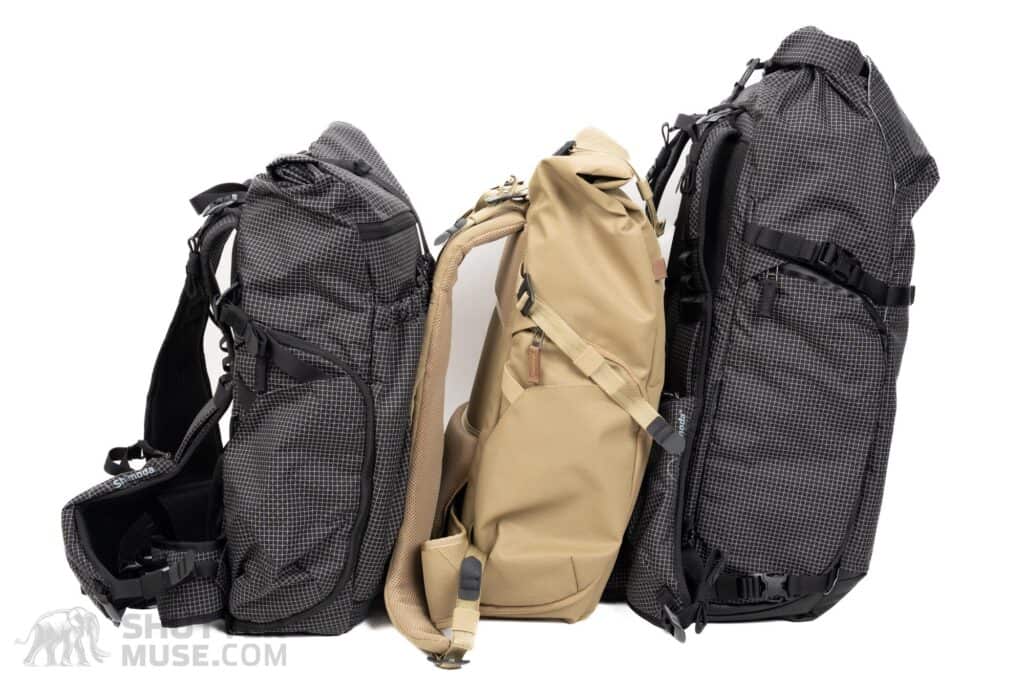
Before we dig into the specifics of the Shimoda Sidecountry backpack, we need to take a second to understand the big difference between Shimoda’s Side Series backpacks and all of its previous camera packs. The Side Series comprises three side-access backpacks that work in conjunction with Shimoda’s Top Loader camera holsters to create a multi-purpose ecosystem of camera-carrying solutions that adapt to your needs as your day or photographic trip evolves.
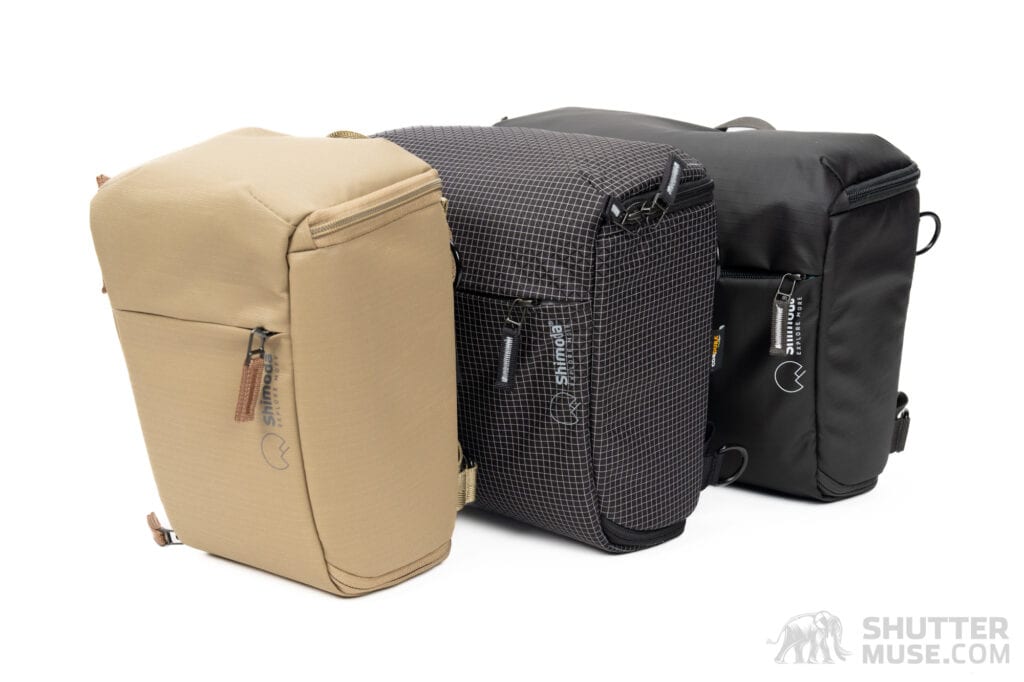
Instead of using the brand’s well-known Core Unit system for camera protection, as seen in the Explore and Action X series of backpacks, the Side Series relies on Top Loader holsters. These offer a protective pod for cameras and lenses within the backpacks and can also be repurposed as shoulder bags, hip holsters, or chest harnesses once removed from the pack.
The Top Loaders are available in three sizes: Small, Medium, and Large. The Small and Large sizes are available in Black or Boa colors. The Medium is also available in Black or Boa, along with a third black and white cross-hatched pattern, which is exclusive to the Side Series bags when purchased as a kit (Top Loader + backpack shell). There is no cost saving to buying the kit, though. All it does is give you access to that medium-sized black and white Top Loader. If you prefer a different size or color, you can purchase the backpack shell and Top Loader separately. To get more details about the holsters, check out my Top Loader review.
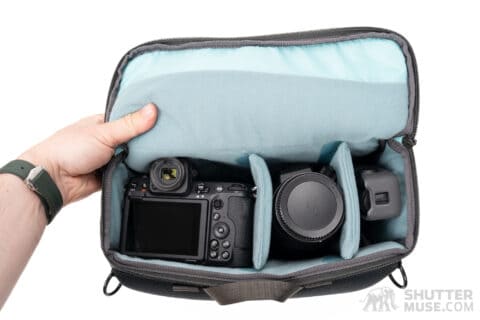
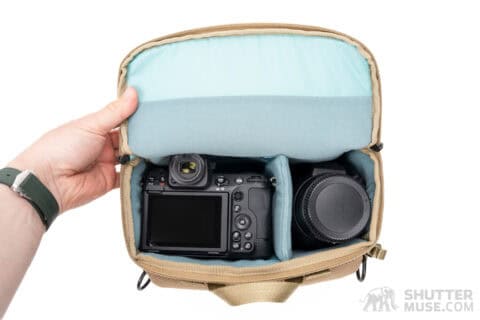
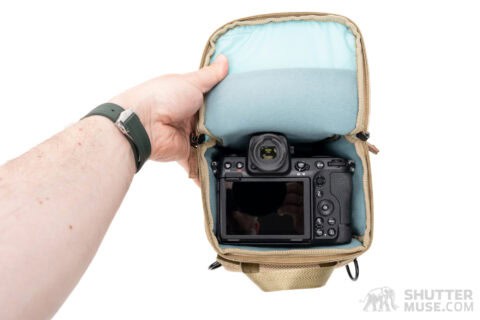
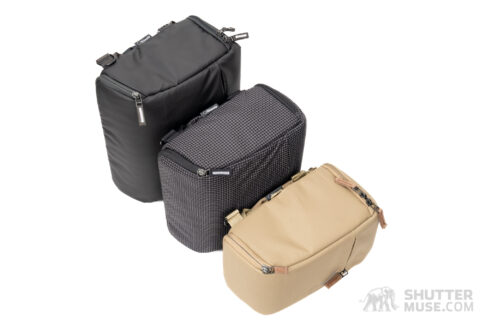
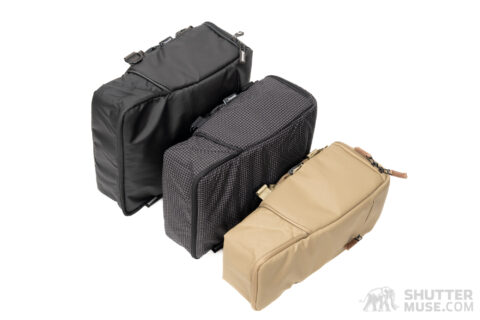
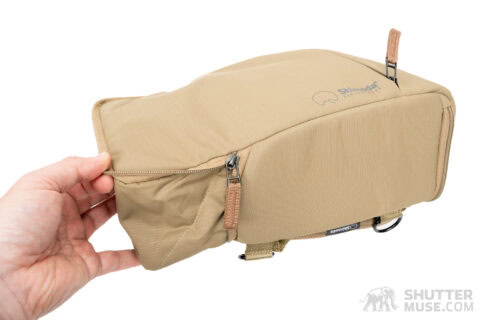
Shimoda Sidecountry Specifications
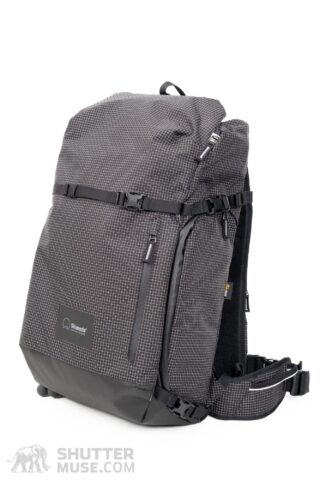
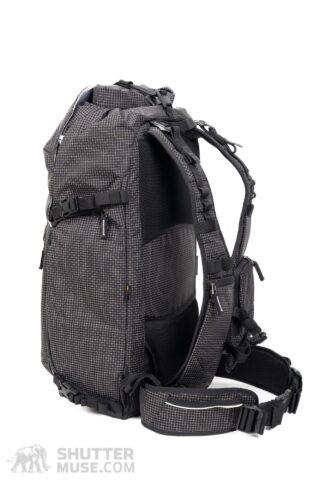
- Flagship-level build and features
- Carry-on friendly with most airlines
- Also available with a women’s harness
- Rain cover included
- Removable 16-inch padded laptop sleeve
- Volume – 28L or 32L
- Outside Dimensions 28L – 10.6W x 18.9H x 6.7D in (27W x 48H x 17D cm)
- Inside Dimensions 32L – 10.2W x 10.6H x 10.2D in (26W x 27H x 26D cm)
- Outside Dimensions 32L – 11.4W x 20.1H x 6.7D in (29W x 51H x 17D cm)
- Inside Dimensions 32L – 11W x 19.7H x 6.3D in (28W x 50H x 16D cm)
- Weight (28L shell) – 3.1lb (1.39kg)
- Weight (32L shell) – 2.9lb (1.32kg)
- 28L Price at review time – $299.95 / $379.90 (kit) – Check current price.
- 32L Price at review time – $319.95 / 399.90 (kit) – Check current price
Shimoda Sidecountry Design and Features
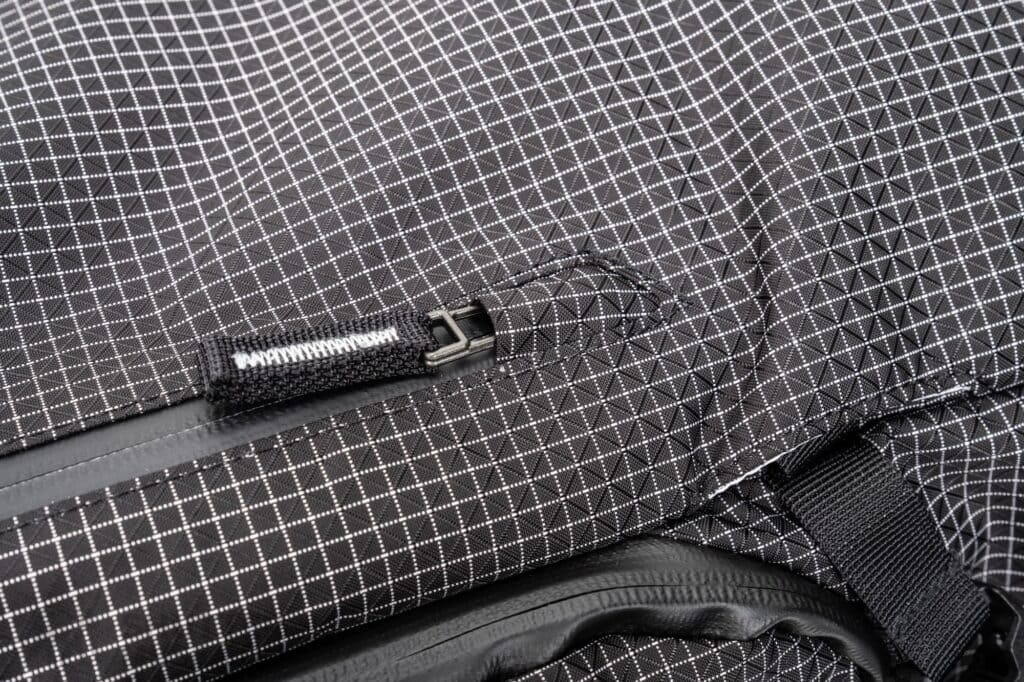
I always like to break down the bag’s features and share detailed images. Shimoda calls the Sidecountry “flagship level,” indicating that they believe this is a match for the Action X and Explore backpacks in terms of build, features, and, subsequently, price point. Let’s dig into those features now and see if that holds up.
Roll-Top
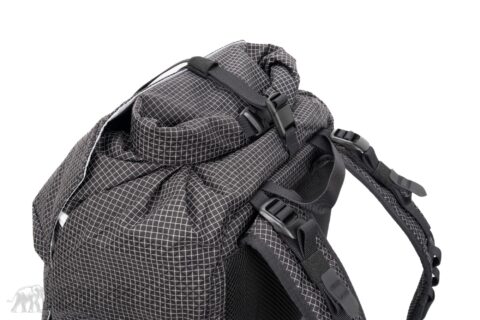
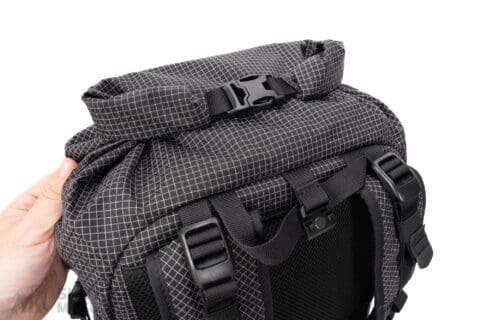
Starting at the top of the bag, you’ll find a magnetic buckle and nylon webbing strap that comes across from the front of the bag and over the roll-top system. We’ll discuss what’s beneath the flap in shortly. Unclipping this magnetic buckle provides access to a roll-top system that allows the volume at the top of the bag to expand and contract.
Aside from the usefully variable volume, a roll-top system like this, made with the weather-resistant material used on the Shimoda Sidecountry, offers more protection against precipitation ingress than a zipper—a valuable benefit of a bag designed for life in the mountains. The mouth of a roll-top bag is also larger than the top of any similarly sized bag with a zipper, which is helpful when packing bulky items or simply for ease of rummaging through smaller items.
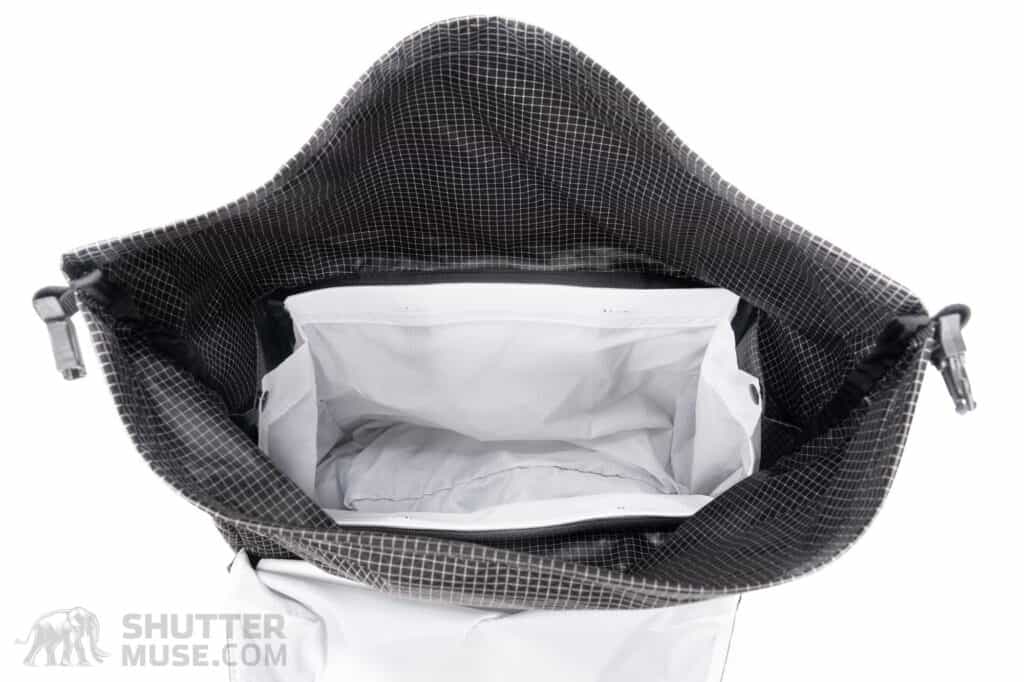
Removable Onsen Bag
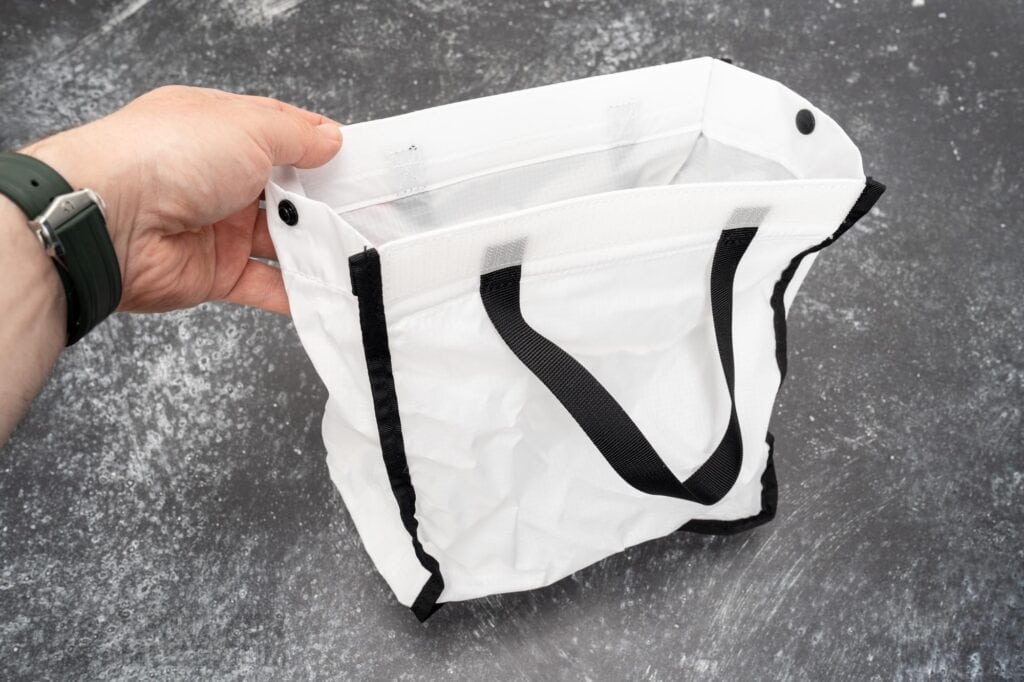
Inside the bag’s roll-top, you’ll find a lightweight removable pocket that Shimoda calls an Onsen Bag. The Onsen Bag is secured to the top half of the bag using hook-and-loop and two snaps. When left in place, the Onsen Bag divides the backpack into two sections, separating your non-photographic items from the Top Loader camera holster in the bottom half. Once removed, the Onsen Bag can be carried using its nylon handles. If you leave the Onsen Bag out of the bag, it functions as a regular backpack with a single 22L internal volume.
Front Stuff Pocket
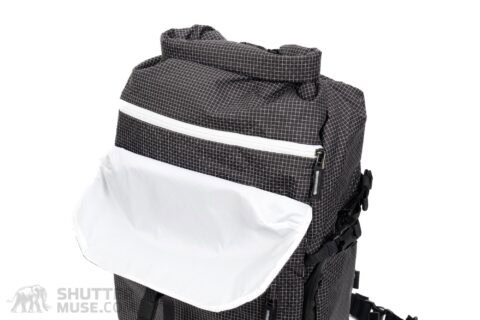
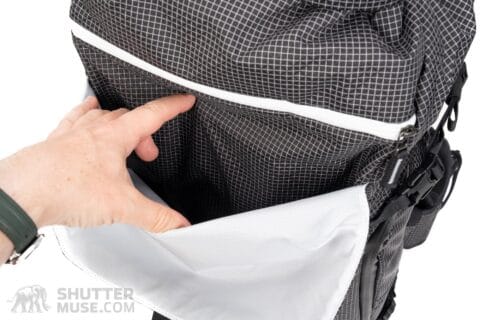
Remember the magnetic buckle and nylon strap that ran across the top of the roll-top? After unbuckling that strap, a large front flap can be opened to reveal a substantially sized stuff pocket. You can use this for quick-access items, such as a rain jacket or insulated mid-layers.
I also find that it’s a great place to stash something like the small Shimoda Accessory Case, which contains frequently needed camera accessories such as batteries and a memory card wallet. Although you can store that case in the roll-top section, it’s much quicker to access it when it’s in the front stuff pocket. Despite not being a zippered compartment, the depth of this pocket and the design of the secured top flap give me confidence that I’m not going to lose anything from it.
If you’re planning to use the Sidecountry backpack for backcountry skiing or snowboarding, this front stuff pocket is also the perfect spot for your shovel blade or skins. One thing that is lacking—something found on the Action X backpacks–is the inclusion of a drainage hole at the bottom of this pocket. Keep that in mind when you’re putting those snowy items back in the pack.
Large Front Zippered Pocket
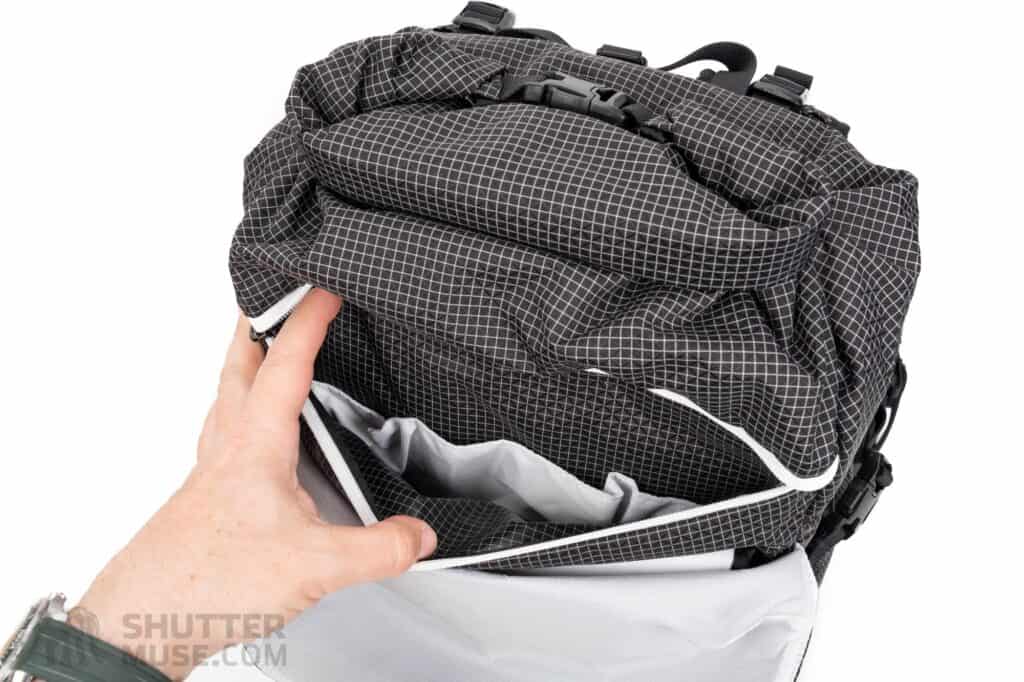
Also behind the bag’s front flap is a large, deep zippered pocket. At the top of this pocket are three nylon dividers that help you organize longer objects, such as a shovel handle or avalanche probe. These dividers have a minimalist design that is appreciated. They offer organization for specialist backcountry equipment, but add minimal bulk or weight for those who don’t need it. As you’ll see in the later tripod carrying section, this zippered pocket is also capable of holding a travel tripod.
Removable Laptop Sleeve
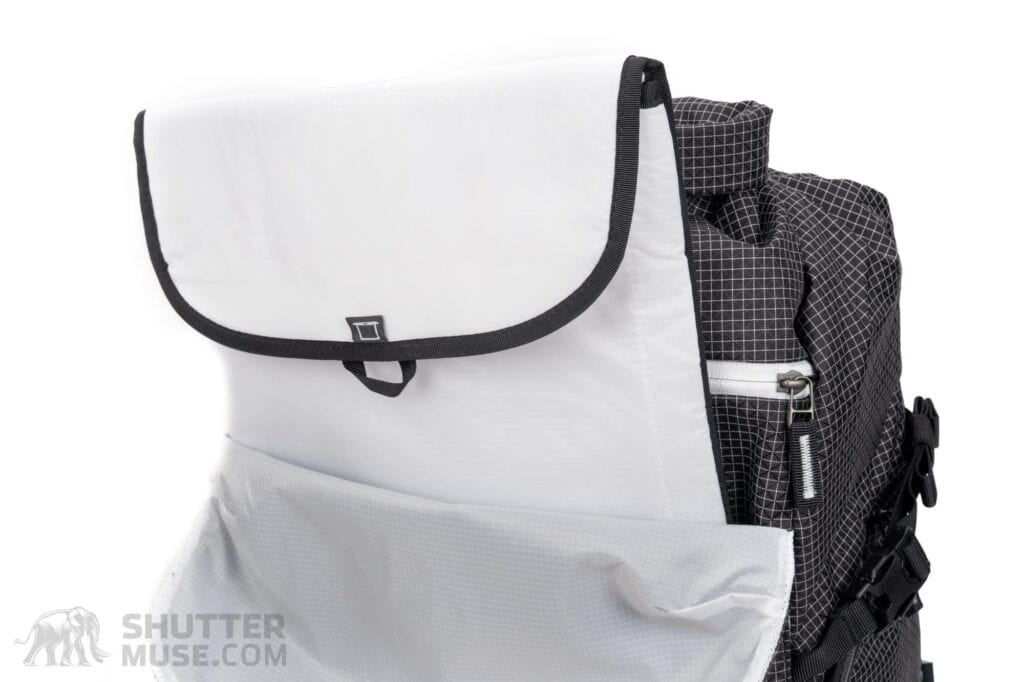
The Sidecountry backpack comes with a removable, padded 16-inch laptop sleeve that slides into the front stuff pocket. Although very few photographers need to carry a laptop through the mountains daily, I am aware that some form of laptop protection is a constant feature request from this bag’s target market. Presumably for use while traveling to a location. What’s nice about Shimoda’s solution is that you can leave the laptop sleeve at home on most days, and you aren’t carrying around a ton of unnecessary padding and material to protect a device you don’t have with you.
Small Front Zippered Pocket
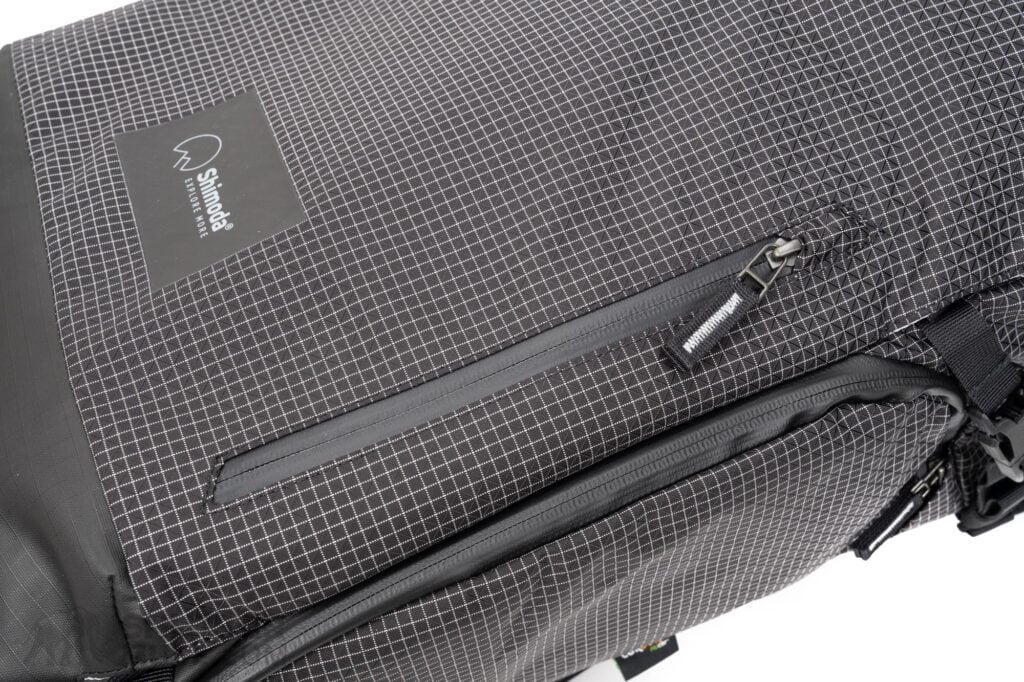
The front zippered pocket is positioned and oriented so that you can access its contents without needing to set the bag down. Swing the bag around your torso off by taking it off your left shoulder, and you have access to your camera gear. If you remove the bag from your right shoulder and rotate it to the front, this zippered pocket will be positioned directly in front of you and oriented correctly. This position, along with the flat nature of the pocket’s interior, makes it ideal for slim, quick-access items such as a memory card wallet, passport, and other travel documents while you’re on your way to your next mountainous destination.
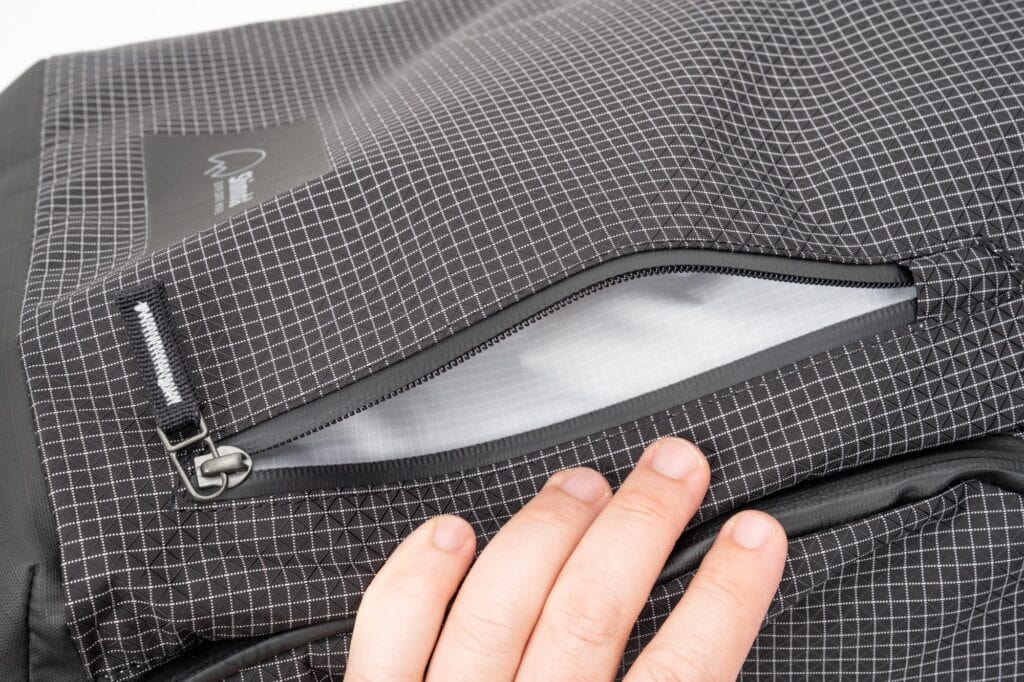
Grab Handles
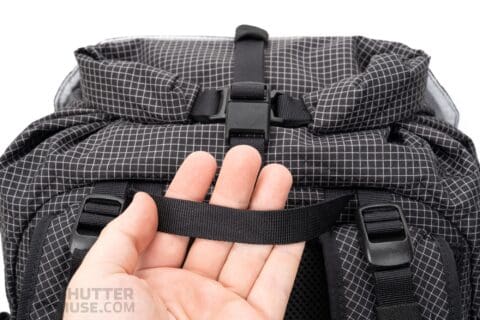

Nylon grab handles at the top and bottom of the bag can be used for moving the bag around on the ground, or extracting it from an overhead locker in an airplane, or a shelf on a bus or train. These are thin handles, designed for very short-term carry.
AirTag Pocket
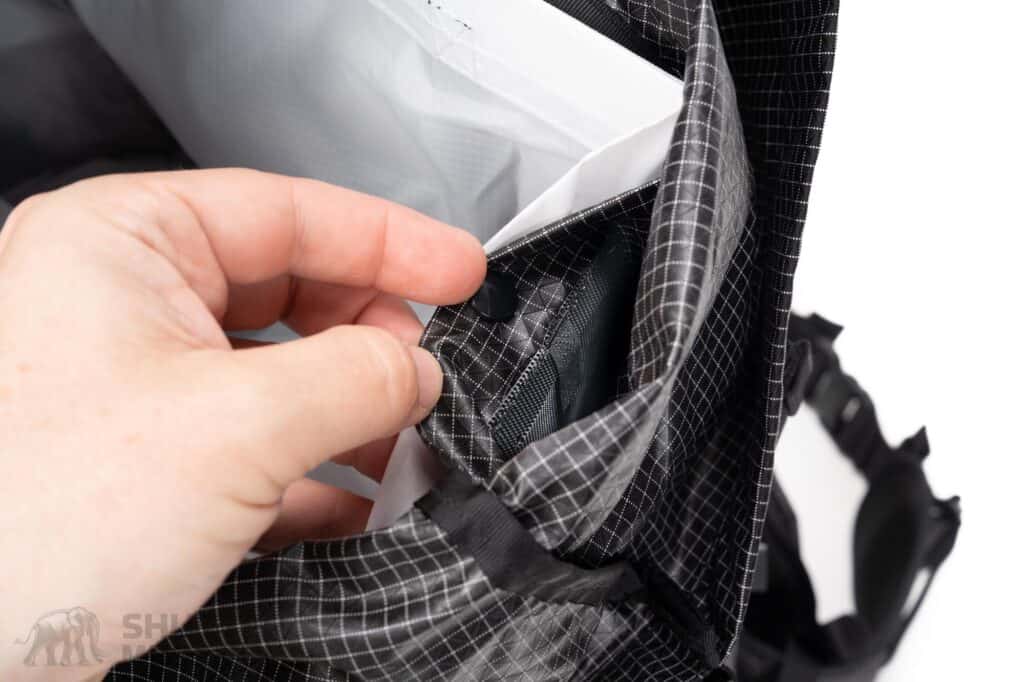
Shimoda has been working to add Apple AirTag pockets to most of its backpacks and accessory bags. The pocket is well hidden within the top section of the bag. Sorry, non-Apple folks. I don’t know if there are any equivalent tracking devices for the Android ecosystem. I have written before about how useful it is to keep track of your gear this way, and I love to see this becoming a standard feature in camera bags.
Side Zippered Pocket
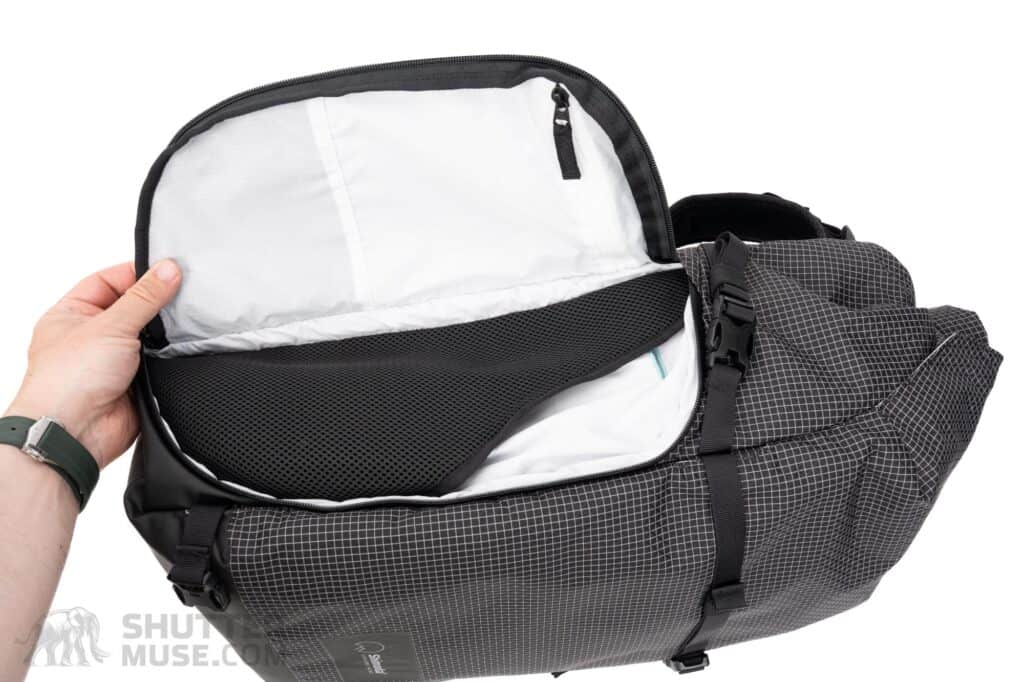
One side of the bag features a large zippered panel. Within the panel is a smaller zippered pocket suitable for a filter or two in plastic filter cases. Alongside this is a somewhat stretchy, slightly padded slip-in pocket that can accommodate a 1-liter Nalgene bottle or a good-sized tech pouch.
At the top of this pocket is a small opening edged with blue stitching. I assumed this was for a bladder hose, as there is also an exit hole on the front of the bag. However, Shimoda designer Ian Miller tells me that it’s for a backcountry radio. The main unit rests in the bag’s side pocket, while the radio cable for the mic threads through to the front of the bag and down the shoulder strap. It’s a niche use, but I’m sure some people will greatly appreciate it.
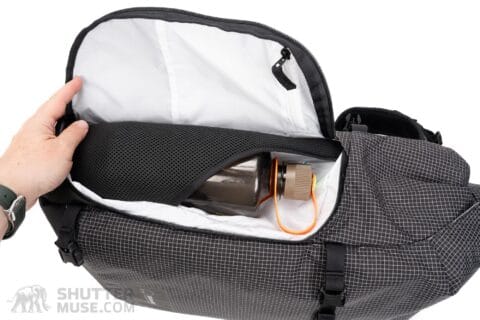
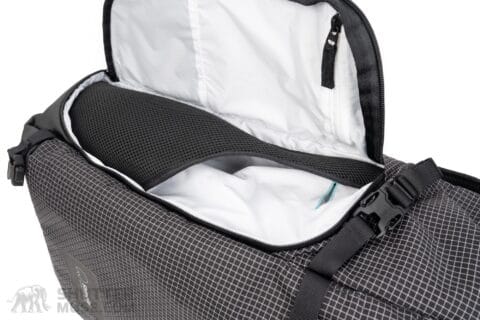
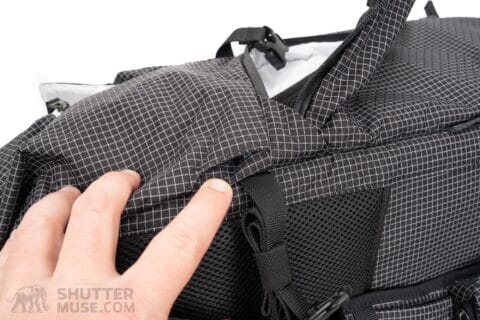
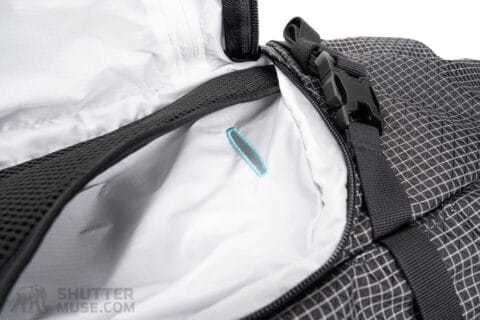
Camera Access
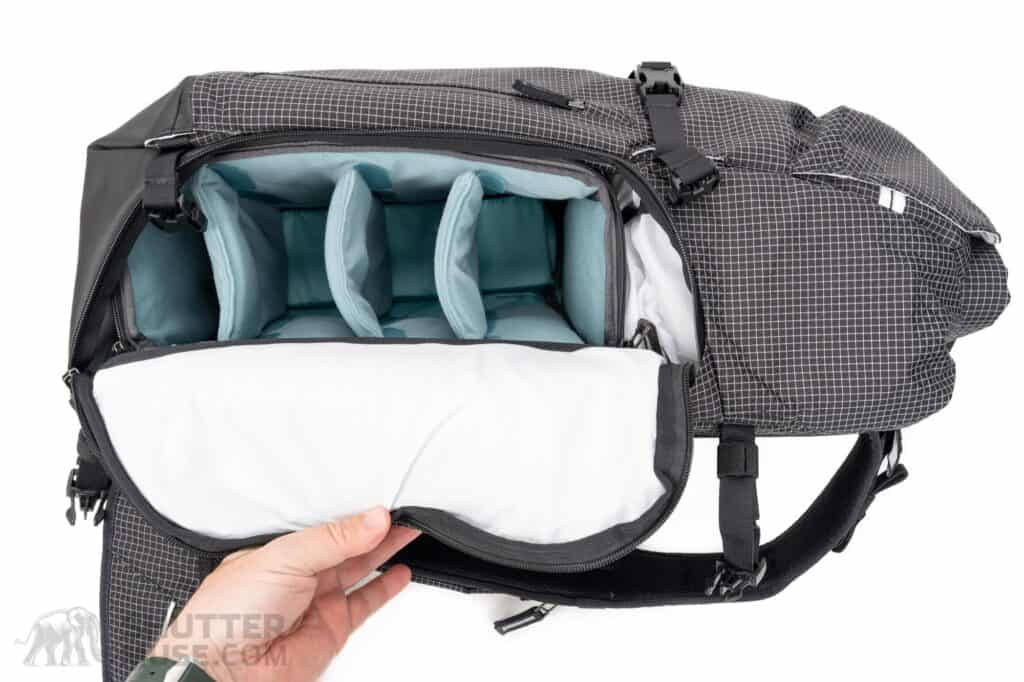
On the opposite side of the zippered pocket, you’ll find an access hatch to the bag’s main compartment. Designed to work with the Shimoda Top Loaders, both the 28L and 32L versions of the Sidecountry are compatible with the small, medium, or large sizes of those holster-style shoulder bags. This side-access design with integrated Top Loaders eliminates the need for the large rear panel access door typically found on most outdoor photography packs, thereby reducing the pack’s weight and allowing for a fit similar to a more traditional mountain pack.
The Top Loaders can be purchased individually, or you can buy the Sidecountry as a kit that includes the bag shell and a medium Top Loader in a black and white hatched pattern matching the bag’s exterior design. Once installed in the backpack, the Top Loader’s lid can be connected to the zippered flap, allowing it to open as one unit, providing you quick access to your gear when you swing the bag to your front shoulder.
Note that the black and white Top Loader from the kit has a white interior, which may or may not be to everyone’s liking. I suspect this will start to look dirty fairly quickly, and I prefer the “Shimoda Blue” interior of the Black and Boa brown colored Top Loaders. There is no cost savings when you buy the kit, so order the size and color of Top Loader that best suits your needs.
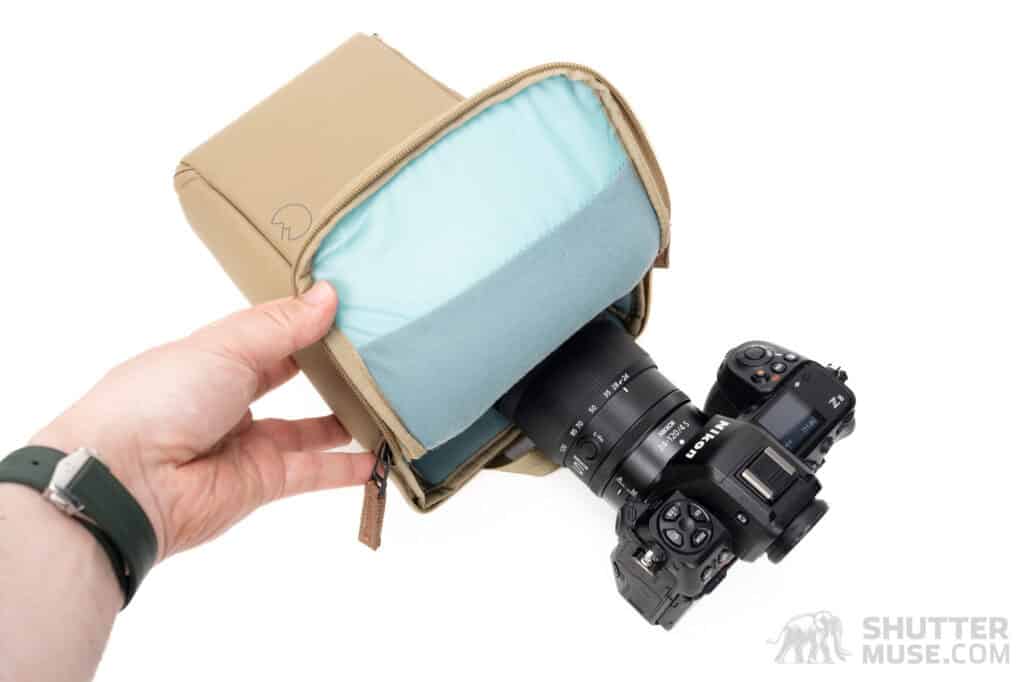
The small Top Loader is sized to carry a mirrorless camera with an attached lens, similar in size to a 24-70mm f/2.8. The medium Top Loader can accommodate a standard-sized mirrorless camera with an attached 24-70mm lens, as well as a second lens. Or you can use the medium to carry a pro-sized or gripped camera body with an unattached lens alongside it. The large Top Loader can accommodate a body with an attached lens and two additional lenses.
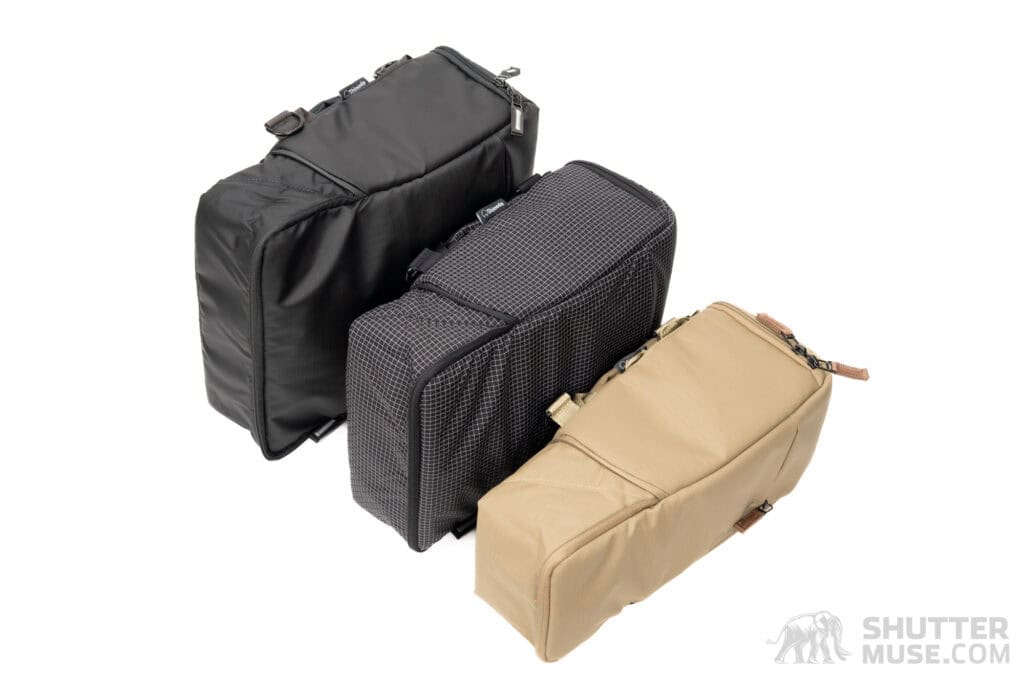
What you need to know when sizing this bag and selecting your Top Loaders is that, while the Top Loaders are expandable, they don’t fit in the Sidecountry bag when expanded. The bag simply isn’t wide enough. I’ve seen other reviews of this bag claiming that it can accommodate a camera mounted with a 70-200mm f/2.8 or similarly sized telephoto lens. While that is technically true, as such a setup can fit in the expanded Top Loader, it would need to be accessed through the roll-top of the bag, and you would have to take the Onsen Bag out of the pack to do this. If you’re not using the side access of a side-access camera bag, you’ve probably chosen the wrong camera bag. If you need a bag large enough to carry a mounted 70-200mm f/2.8 or 100-400mm, I recommend looking at Shimoda’s Action X series.
Tripod Carry
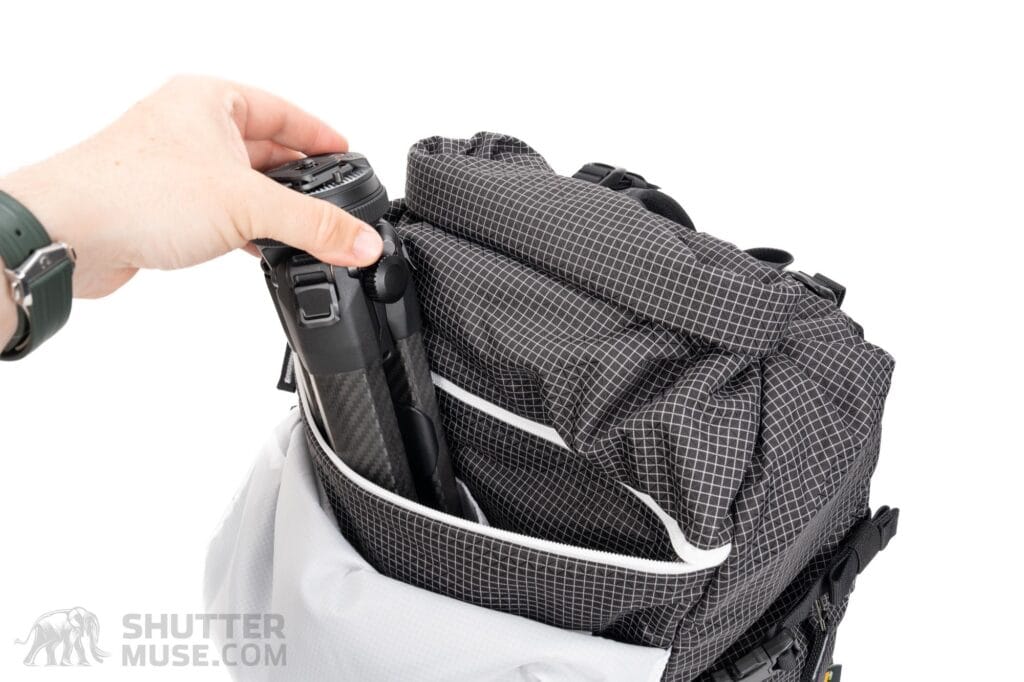
There are three ways to carry a tripod in the Sidecountry. Firstly, if you have a relatively short travel tripod, you can slip it into the front stuff pocket or even the zippered front pocket. The 32L version easily swallowed the 15.5″ (39.4 cm) long Peak Design travel tripod.
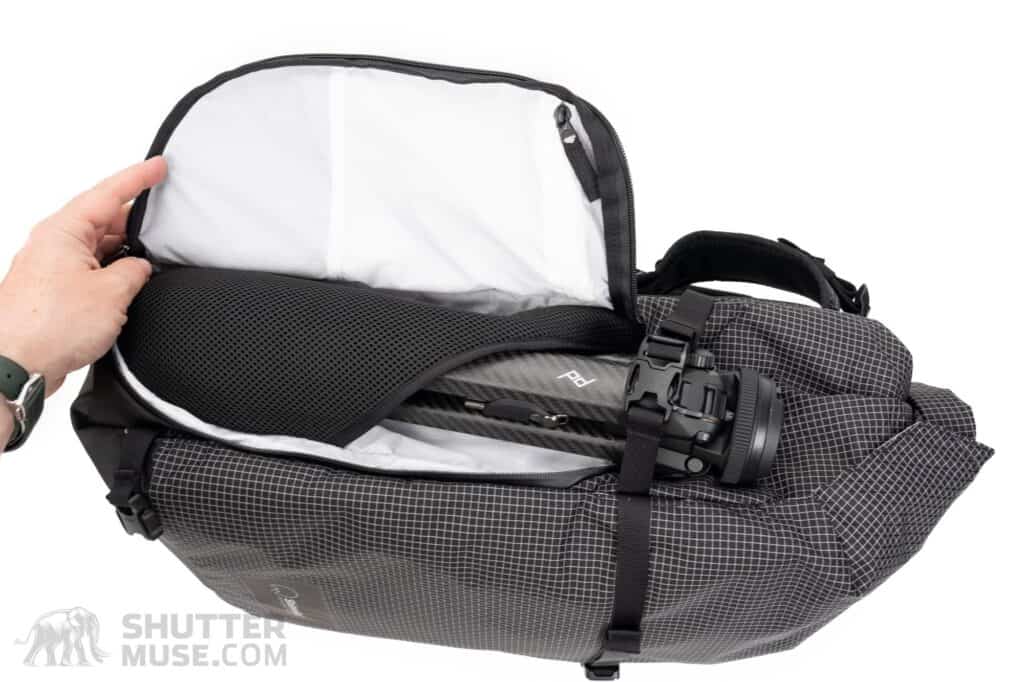
The second way is to open the bag’s side zippered panel and stick the legs in the pocket. The tripod will almost certainly protrude from the top of the pocket; however, you can use the side strap to secure it, and the zipper can be closed around the side and bottom of the pocket, just so long as you are using a tiny diameter travel tripod.
The third way to carry a tripod is to hang it on the side or front of the bag using the available straps and buckles. While this is doable, the lack of a traditional tripod side pocket to support the tripod’s feet places the tripod’s weight on the top strap when you pass it through the tripod legs. It feels a little awkward with anything larger than a medium-sized tripod. Strangely, the Shimoda Side Lite, a bag designed to be stripped of features to achieve the lowest possible weight, does feature a side tripod pocket. It would have been a nice feature to have on the Sidecountry, too. I’d recommend anyone wanting to carry a larger tripod look to the Action X series, which features a dedicated pair of removable side-mounted tripod pockets.
Front Accessory Straps
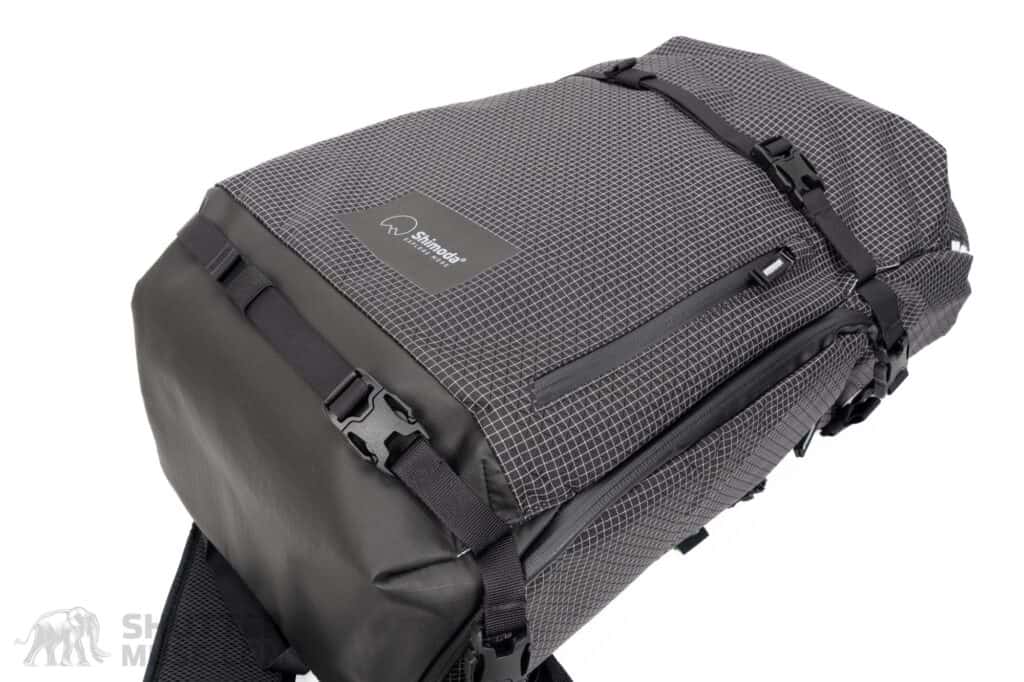
Invisible when you first unpack the bag are a pair of accessory straps that can be deployed to secure things like show shoes, tripods, or even a snowboard to the front of the pack. When you don’t need these straps, they can be tucked into holes on the side of the front stuff pocket to make them dissapear.
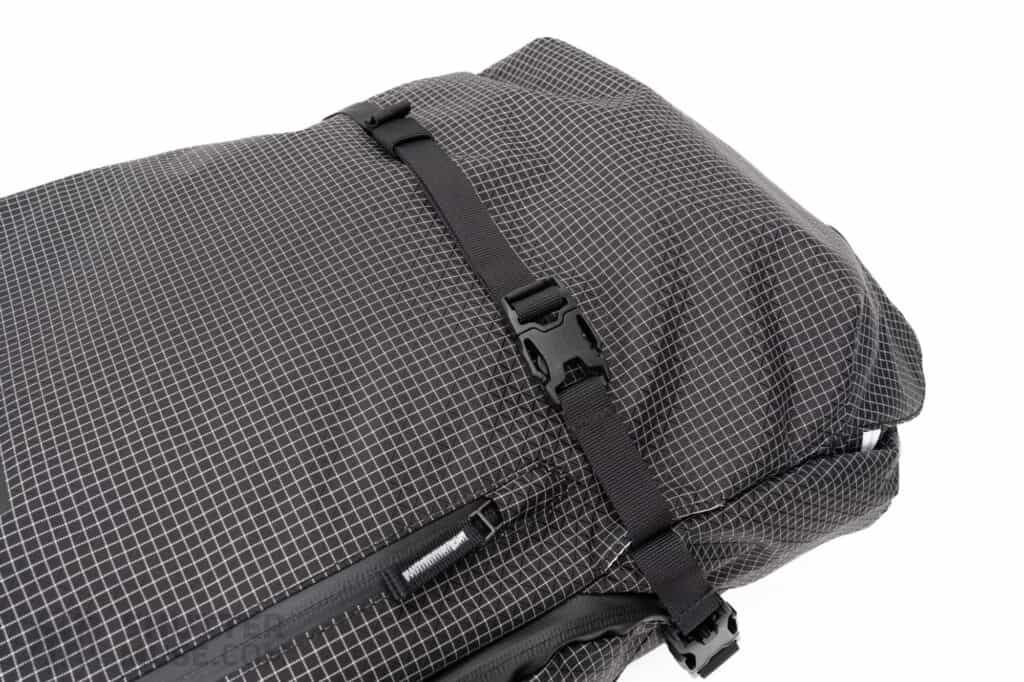
Side Accessory or Compression Straps
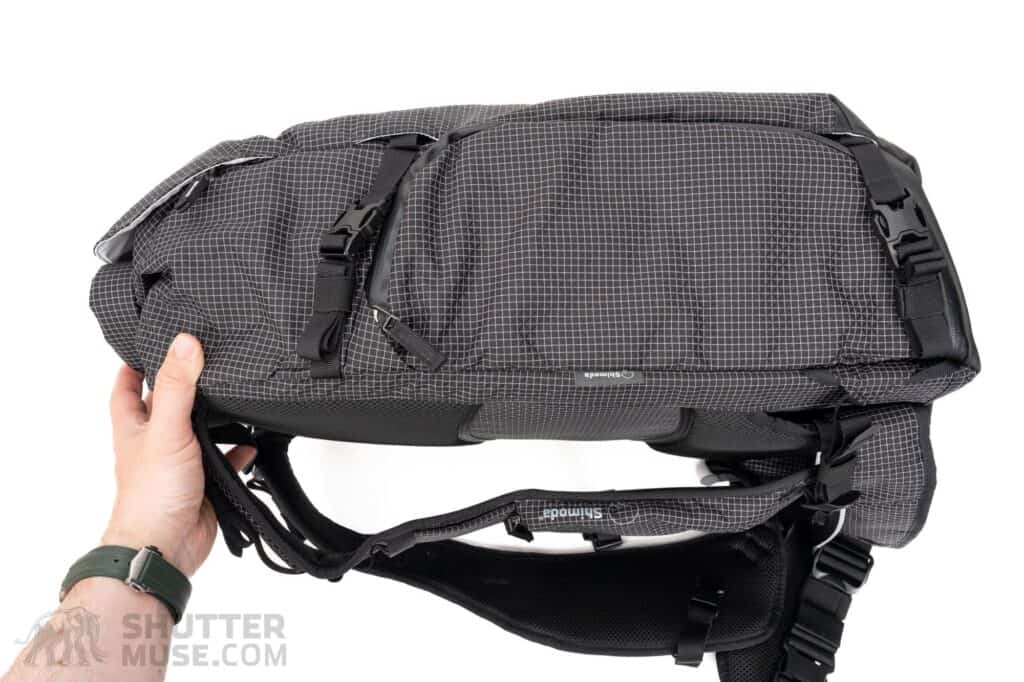
Both sides of the Shimoda Sidecountry backpack feature a pair of side straps positioned above and below the zippered hatches to ensure they don’t interfere with side pocket or camera access. These straps can be used to attach gear to the side of the pack or to compress its volume if it hasn’t been fully packed. If you don’t need to use these straps, they can be unbuckled and then tucked through dedicated holes to conceal them. This is particularly useful on the side of the pack that features the camera access hatch. Attaching anything to that side of the pack prevents you from easily getting to your camera, so I tucked the straps away on that side and don’t use them.
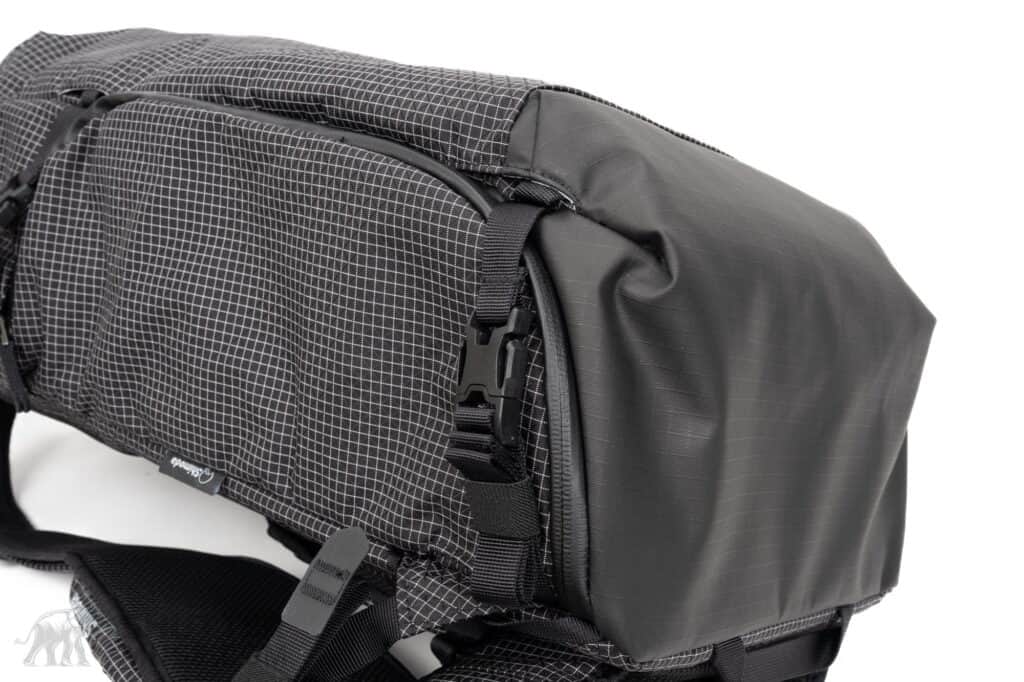
Sternum Strap
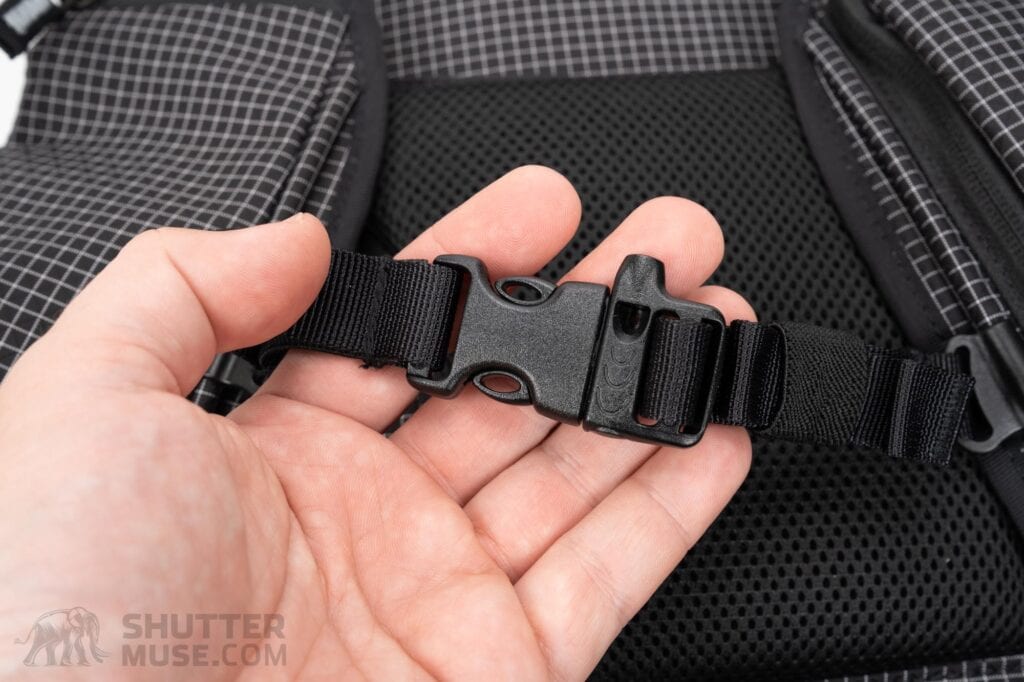
The Shimoda Sidecountry’s sternum strap is easily adjustable and features a safety whistle, an elasticated section that makes it feel a little less constrictive while you move around or breathe heavily, and an elastic strap keeper to tidy up the slack.
Back Padding and Lumbar
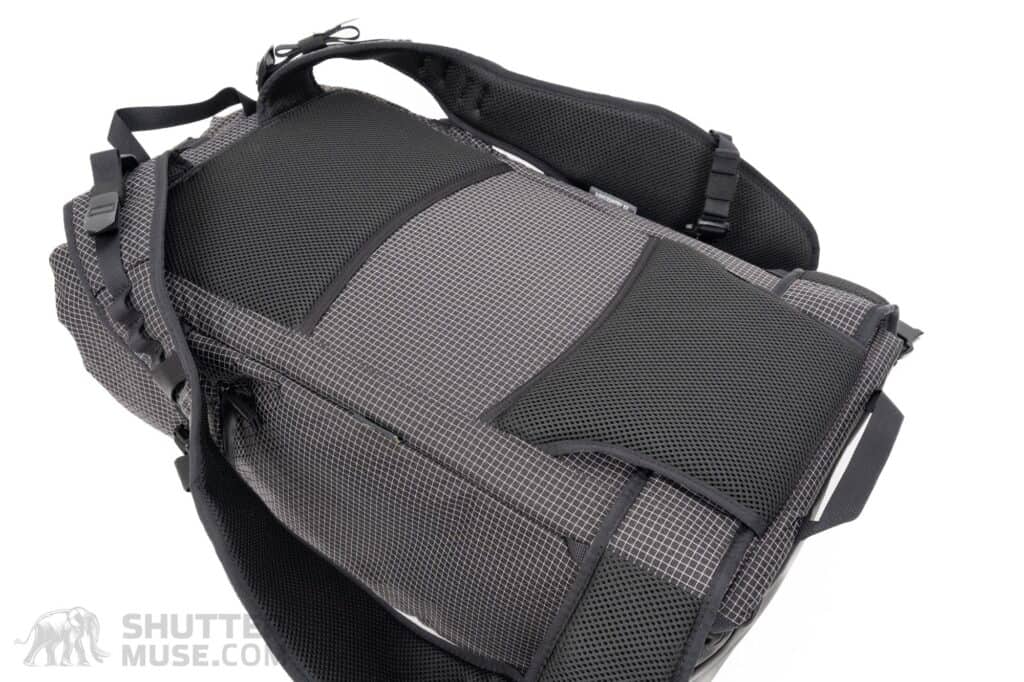
On the bag’s back panel, you’ll find two sections of padded, aerated mesh. I found that this setup provided ample comfort for a bag of this size. The lower of the two padded sections, the lumpar pad, is thicker.
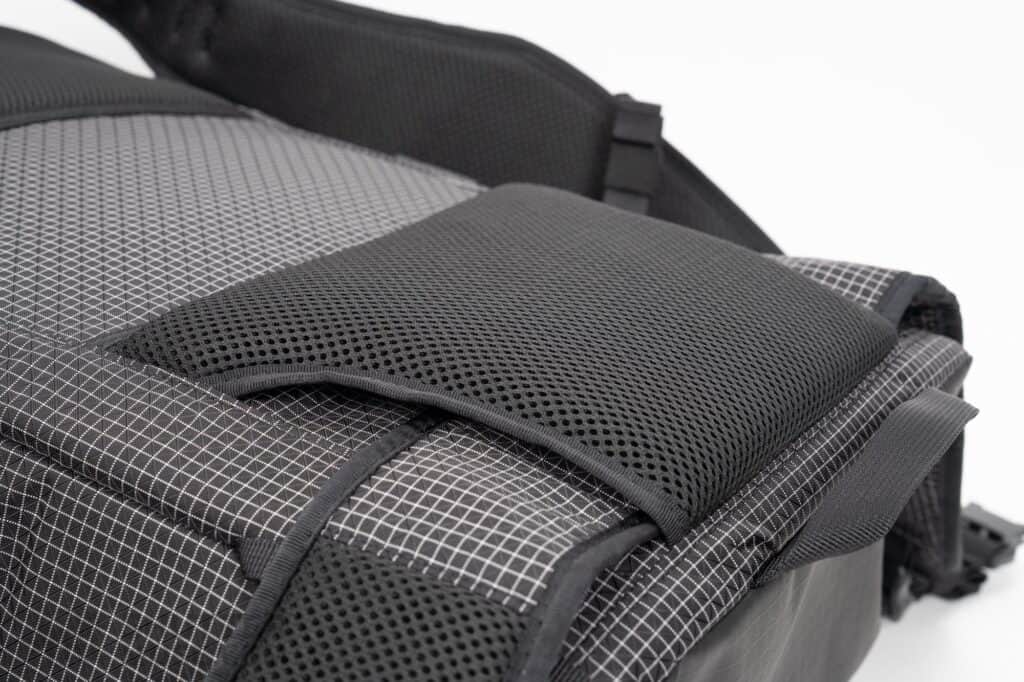
Shoulder Straps
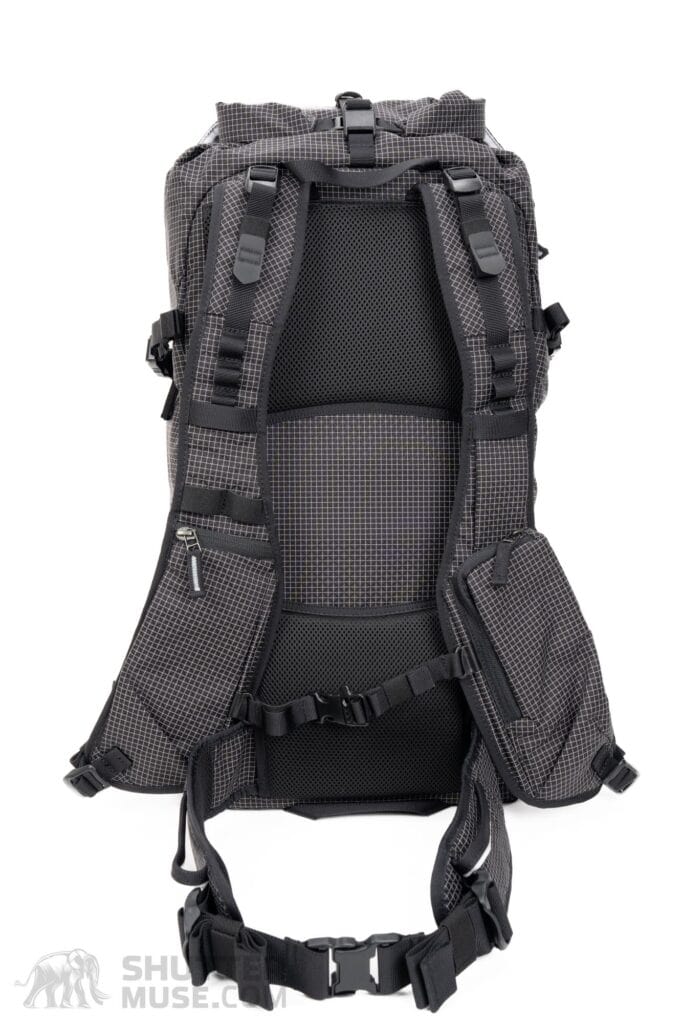
The shoulder straps on the Sidecountry backpack feature all the same features as its larger siblings in the Explore and Action X range. The left-hand shoulder strap features a zippered phone pocket that can hold an iPhone 16 Pro Max. The right-hand shoulder strap features another zippered pocket that can hold a small collapsible water bottle, or a can of bear spray–handy for people like me who live in bear country!
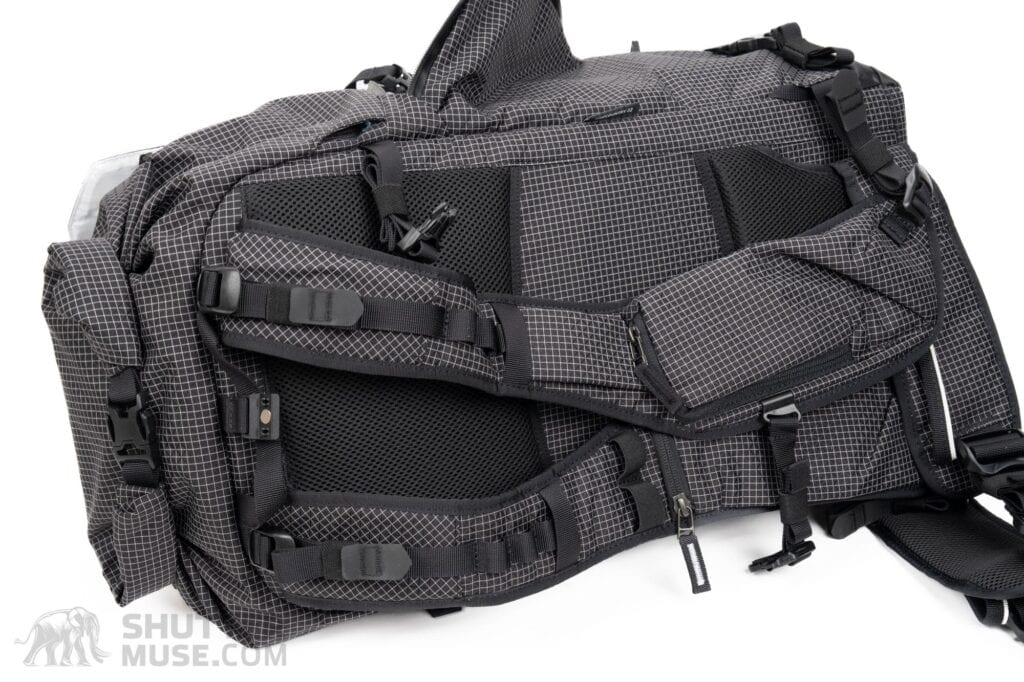
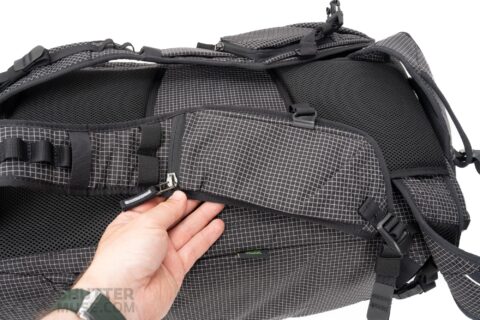
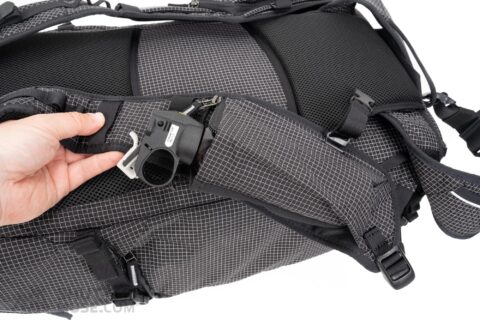
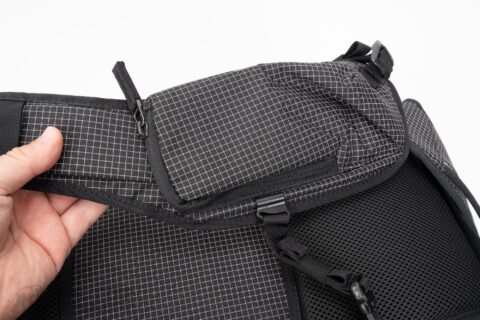
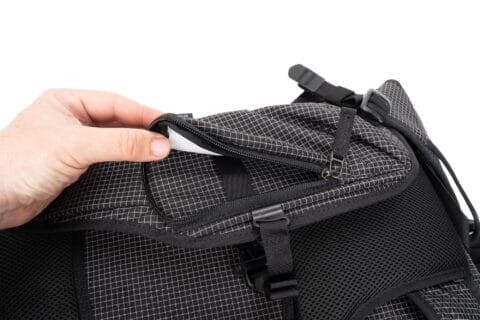
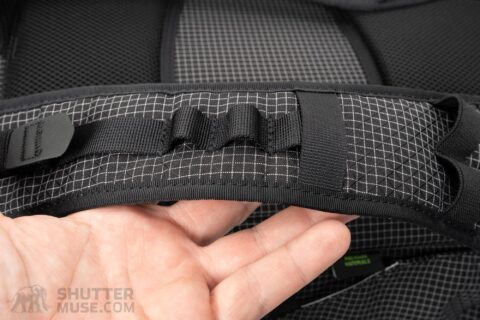
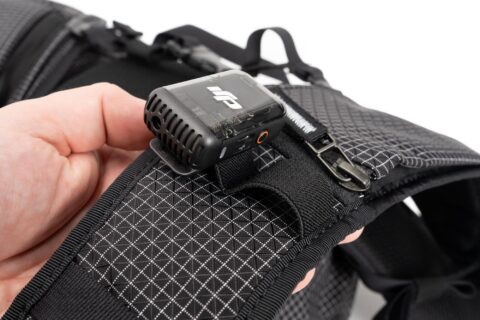
You’ll also find a selection of nylon and elastic loops for attaching small accessories such as GPS devices or even wireless microphones. The left-hand strap also features an action camera rail that is compatible with the Peak Design Capture Clip and similar knock-off products.
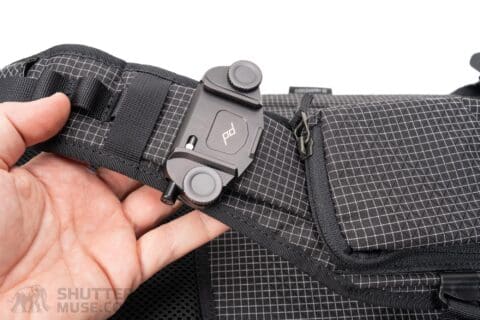
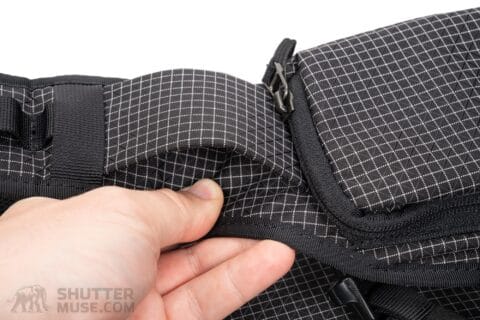
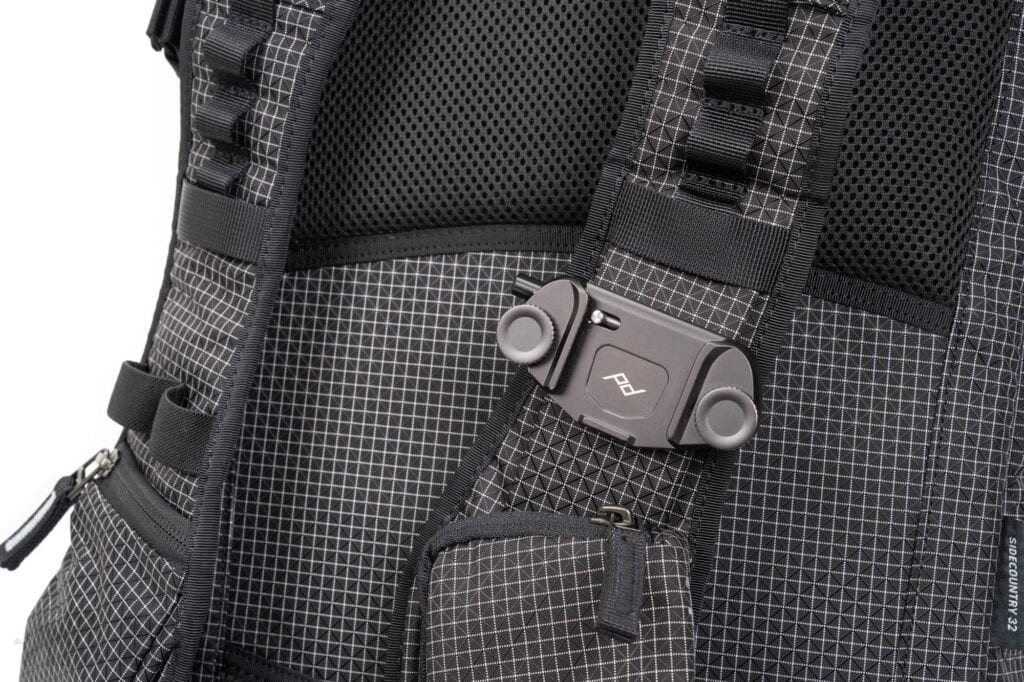
Hip Belt
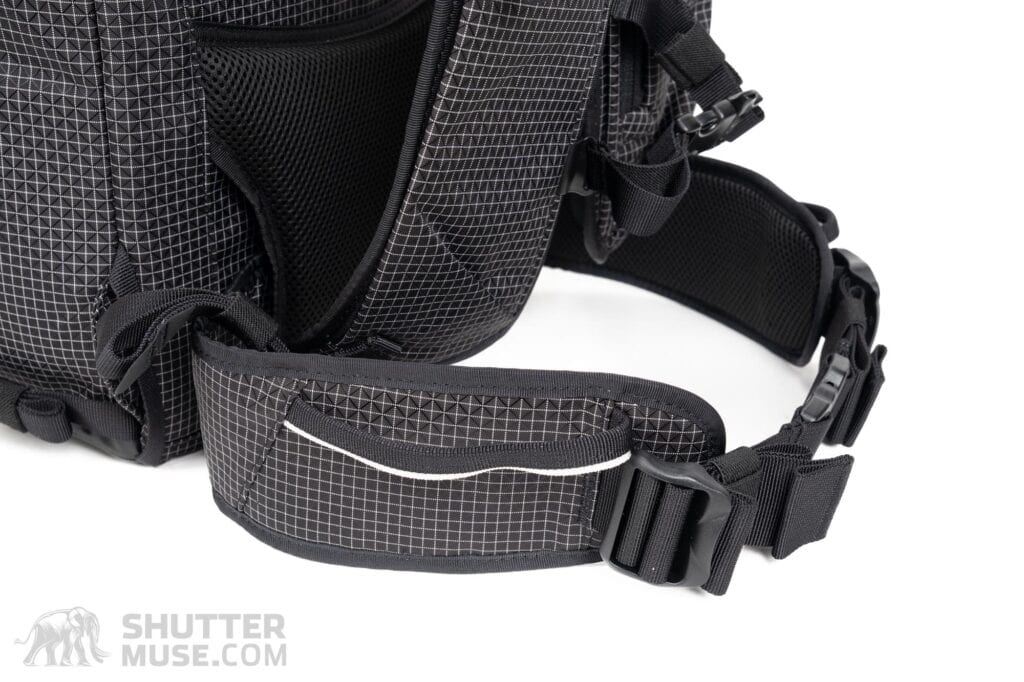
The Shimoda Sidecountry’s hip belt is lightly padded, features a rail on each side for attaching carabiner accessories, and is removable. Elastic strap keepers manage any dangling straps, and the belt can be configured in what Shimoda calls ‘locked-in’ or ‘free fit’ options. The locked-in setting widens the rear portion of the hip belt by threading it through two nylon webbing straps, which helps keep the bag closer to your back with reduced pack movement – ideal for active pursuits.
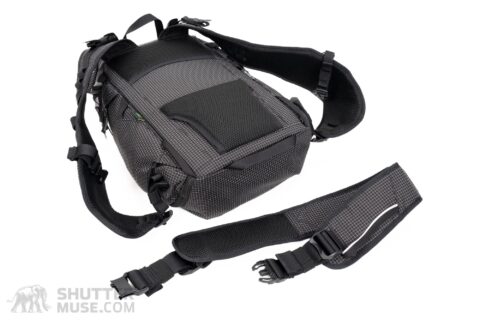
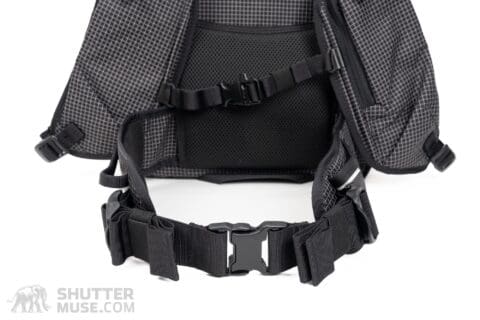
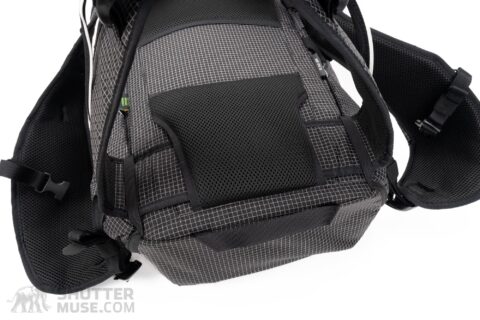
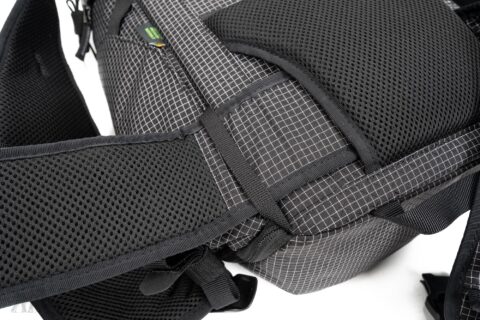
Rain Cover

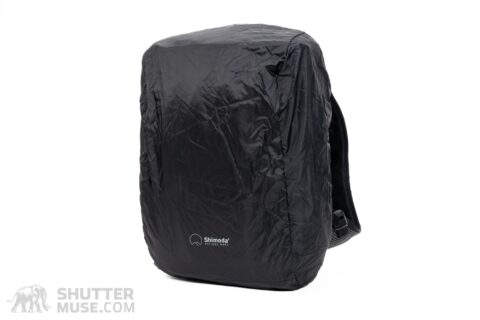
The Side Lite comes with a black rain cover. Including a rain cover is especially important with this bag because the front pocket lacks an additional closure mechanism beyond elastic. Without a rain cover, the items in the bag’s front pocket would quickly become wet during a heavy rain shower.
Can You Use Core Units in the Sidecountry?
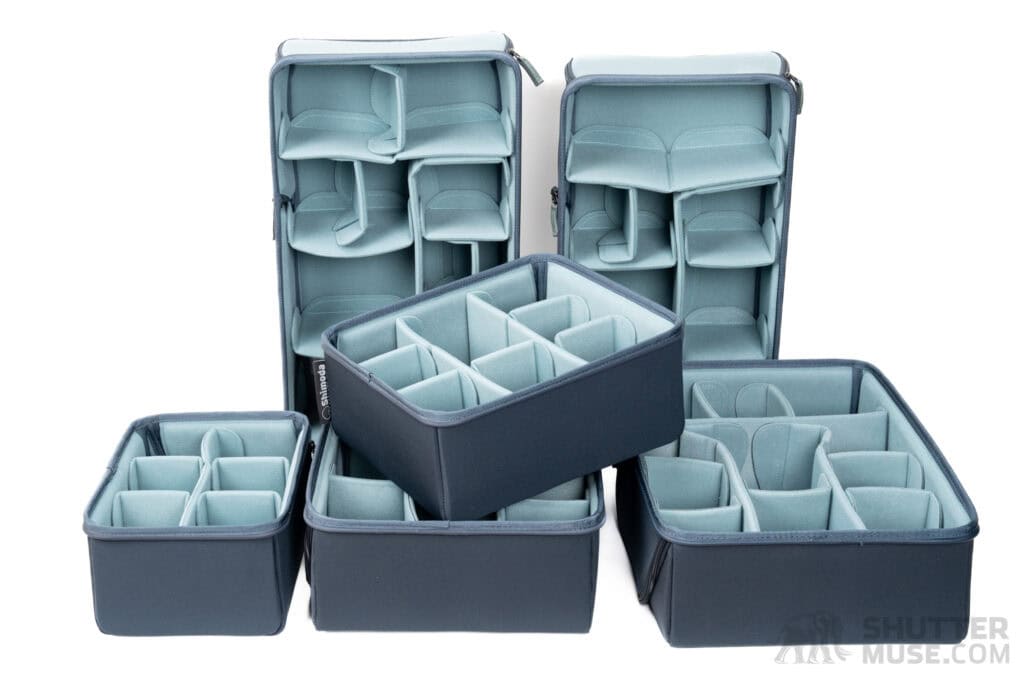
The Shimoda Sidecountry is designed to be used with the three sizes of Shimoda Top Loader, not the standard Core Units. Unlike Action X and Explore Series backpacks, the Side Series packs do not feature a zippered back panel. Although they have a side access door, and you might be able to use it with a Core Unit that also has a side access hatch, the depths of the Core Units do not perfectly match the depth of the Side Series bags. Most of them fit somewhat loosely, which can cause contents to slide out if the rest of the bag isn’t packed tightly.
I tested all the Core Units with the Sidecountry, and found only one that made any sense: the XL30 RST in the 32L Sidecountry pack. This was a near-perfect fit, and allows you to extract a large telephoto lens like a 200-600mm vertically from the pack’s roll-top, while accessing a second shorter telephoto, like a 70-200mm, through the side hatch. That said, it provides a similar amount of usable space to using the L25 RST in an Action X25 pack, demonstrated in this article, so you’d have to have a good reason for choosing the Sidecountry pack instead of that one.
Compared to Other Side Series Backpacks
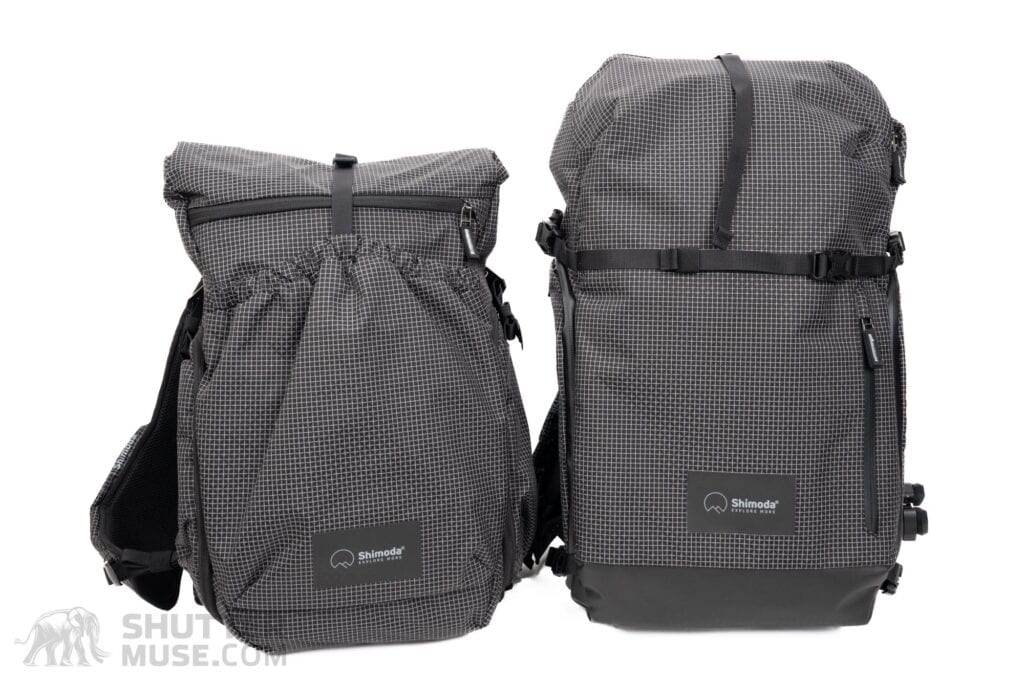
If you’re considering Shimoda’s Sidecountry backpack, you may wonder whether the other Side Series backpacks, such as the Side Street or Side Lite, might be a better solution for your needs. The Site Lite is only available with a 22L volume, while the Side Street comes in 22L and 28L varieties. The largest of the three bags in the series is the Sidecountry, available in 28L or 32L sizes. The available volumes alone may influence your decision. Also noteworthy is that the Large Top Loader doesn’t fit in the Side Lite, but does fit in both sizes of the Side Street, and both Sidecountry models. Further differences are noted in the table below, or you can read my Shimoda Side Lite review or Side Street review.
| Feature | Side Street | Side Lite | Sidecountry |
|---|---|---|---|
| Volume | 22L or 28L | 22L | 28L or 32L |
| Weight (shell) | N/A | 2.4 lb | 2.9 lb or 3.1 lb |
| Weight (kit with medium Top Loader) | 3.9 lb or 4.2 lb | 3.5 lb | 4.4 lb / 4.6 lb |
| Color | Anthracite or Boa | Black & White | Black & White |
| Laptop Sleeve | Up to 16″ | No | Up to 16″ |
| Laptop Sleeve Is Removable? | No | N/A | Yes |
| Hidden AirTag Pocket | Yes | No | Yes |
| Removable Onsen Bag | Yes | Yes | Yes |
| Small Top Loader Compatibility | Yes | Yes | Yes |
| Medium Top Loader Compatibility | Yes | Yes | Yes |
| Large Top Loader Compatibility | Yes | No | Yes |
| Available as a Kit with Medium Top Loader | Yes | Yes | Yes |
| Available As an Empty Backpack Shell? | No | Yes | Yes |
| Sternum Strap Safety Whistle? | No | Yes | Yes |
| Side Tripod Pockets | Yes | Yes | No |
| Removable belt | Yes | Yes | Yes |
| Shoulder Strap Phone and Accessory Pockets | No | Yes | Yes |
| Camera Clip Compatible Shoulder Strap | Yes | Yes | Yes |
| Price at Review Time – Shell Only | N/A | $239.95 | $299.95 (28L)/$319.95 (32L) |
| Price at Review Time – Kit | $269.95 (22L)/$299.95 (28L) | $319.90 | $379.90 (28L)/ $399.90 (32L) |
Conclusion
The Shimoda Sidecountry ranks at the top of the brand’s Side Series of side-access outdoor camera backpacks and is compatible with all sizes of the Shimoda Top Loader bags for camera protection. The combination of a backpack with the Top Loader holster/shoulder/belt bag creates a versatile, multi-purpose carrying system designed for long days of travel and mountain exploration. I love the concept and implementation of that smaller, removable bag for when you don’t need the whole pack.
Having tested all three bags in the Side Series lineup, I can confidently say that the Sidecountry is my favorite. It combines the fully featured shoulder straps and lightweight yet durable materials of the Side Lite backpack with the enhanced range of features and organization of the Shimoda Side Street backpack.
What most impressed me about this bag, aside from its comfortable ergonomics, is its volume-to-weight ratio. While not as light as the ultralight Shimoda Side Lite backpack, it’s not far off, and still comes in significantly lighter than comparably-sized backpacks in Shimoda’s Explore or Action X backpack series. You can feel that weight difference during a long day, especially when carrying a minimal camera setup in either the small or medium Top Loader.
While the Sidecountry is an innovative design with a long list of great features, two things jump out at me for consideration when it comes to figuring out if this backpack is right for you. Firstly, the lack of a dedicated tripod side pocket makes it a less-than-ideal bag for anyone wanting to carry a tripod larger than a small to medium-sized travel tripod. Looking at the Shimoda Action X lineup is a better bet if you want to carry a set of big sticks.
Secondly, the side-access design of the bag, which contributes to its low overall weight, limits the length of the lens you can carry attached to your camera. The Top Loader bags that fit into the Sidecountry can accommodate a mounted 70-200mm f/2.8 or 100-400mm, but only in their expanded mode. In this expanded mode, they cannot fit sideways into the Sidecountry, so I do not recommend this bag if you want to keep one of those lenses (or a larger one) attached to your camera. If these two caveats don’t apply to you, and you’re looking for a lightweight, high-quality backpack for outdoor photography, the Shimoda Sidecountry is a great proposition.
Where to Buy (+ Save 10%)
Shimoda Designs has offered Shutter Muse readers a 10% discount on anything purchased through their online stores. US, Canadian, UK, French, or German residents should use the discount code ShutterMuse10 after clicking here to access the store. Australian readers should use the same code on the local Shimoda distributor’s site, Maxxum, instead.
It’s always appreciated when you use my links for your purchases. I recommend shopping directly with Shimoda, if you can, to take advantage of that 10% discount. However, using one of our other links is also appreciated if you are unable to do so.


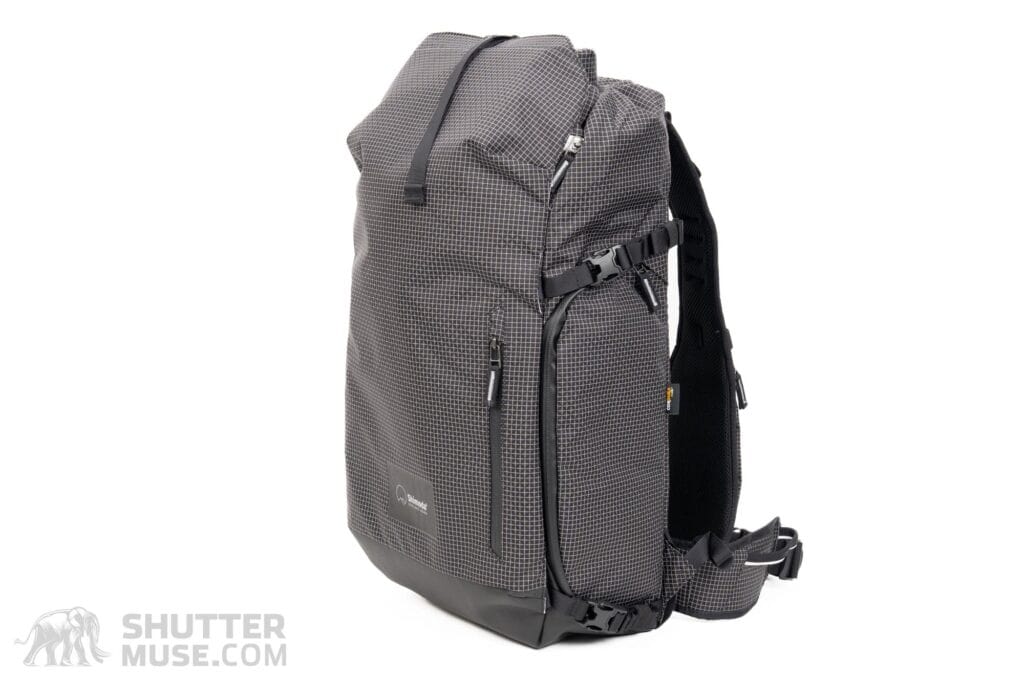
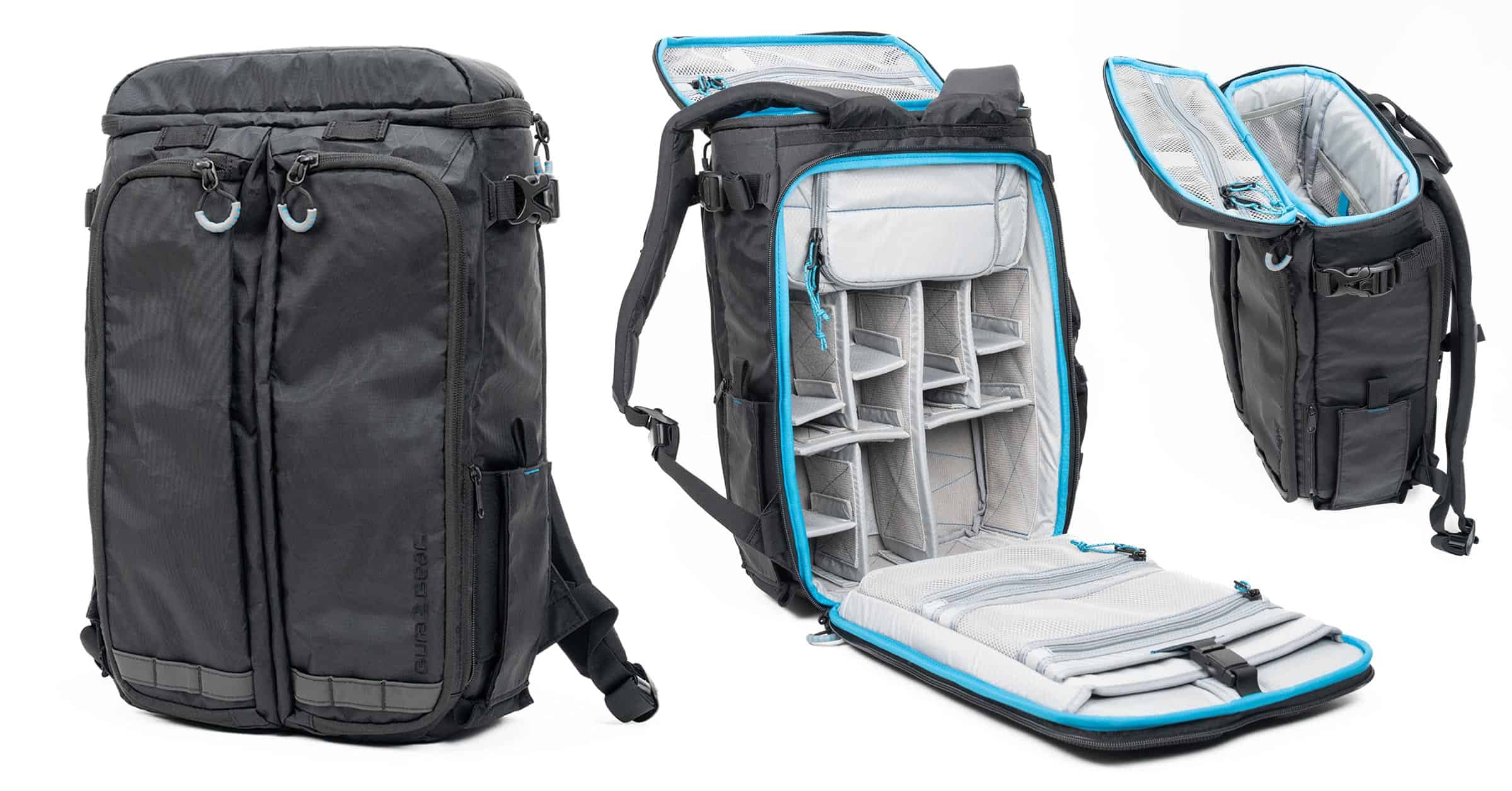
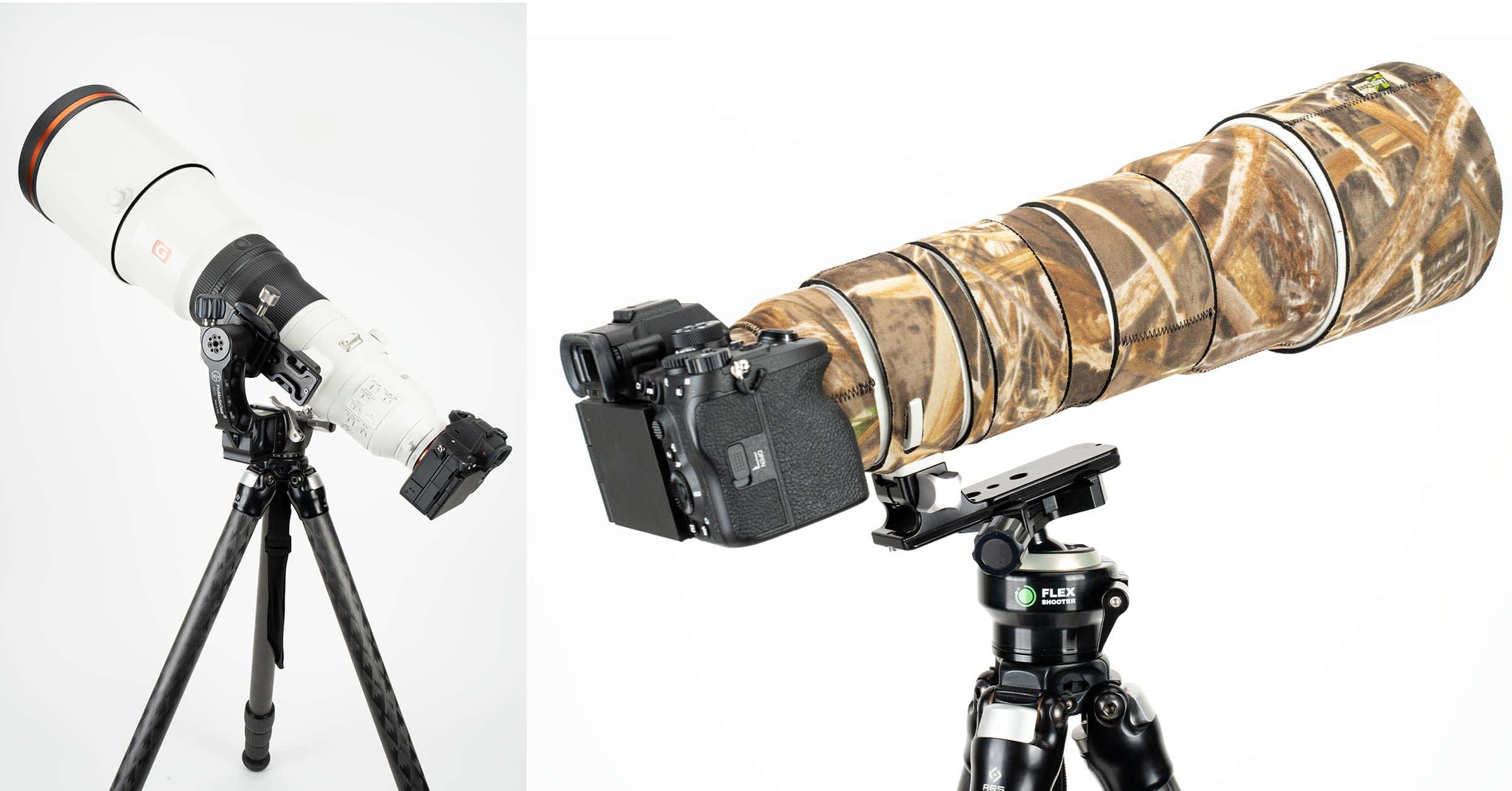
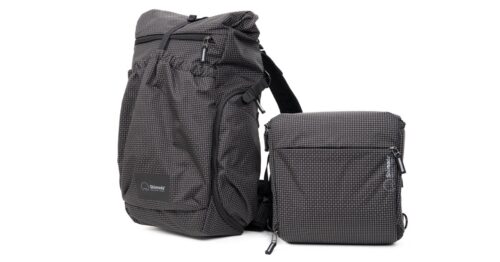
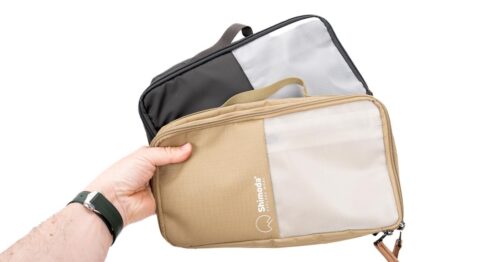
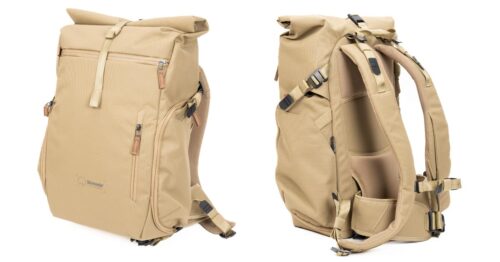
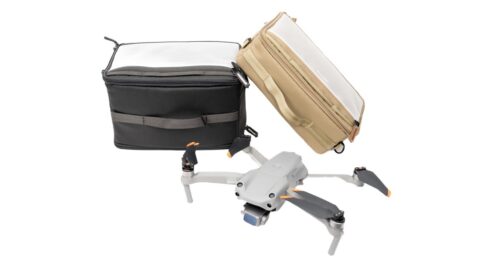
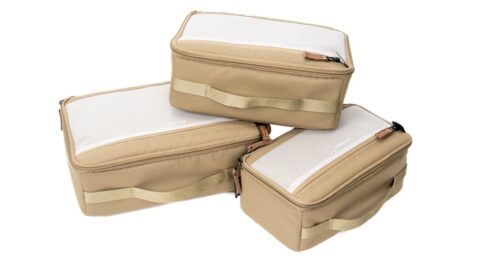

Thanks, Dan. A lot of good observations. I have a Side Country 28 kit on the way. I also have an Action X 30 v2 which I will use when I carry more gear and a medium to large tripod.
I did want to point out something about the fit. I am a Sony shooter and have one of the original Top Loaders (equivalent to the “small” version). I need to “expand/extend” it for my Sony full frame a7r5 body (with L bracket) if I want to have the 70-200 2.8 attached. But in my case when I am hiking I carry a Sony 70-200 F4 Mark 2 as it is lighter and shorter and is all I need for landscape photography. The a7r5 w/ L-bracket with an attached 70-200 F4 w/ hood reversed will fit in the non-expanded or “compact” version of the small Top Loader. Since the Medium Top Loader is the same depth I expect that setup to fit there as well. I will add the Sony 20-70 F4 and the Sony 16mm F1.8 for hiking. I shared this on the Shimoda FB group and Ian pointed out that in fact you can extend the Top Loaders when they are placed sideways in the Side Country. I don’t know if you get the full depth of the Top Loader but Ian stated that an attached 100-400 lens would fit.